Discovering the Living History of Punjab, Sindh, KPK & Gilgit Baltistan
📜 Table of Contents – Heritage in Pakistan
- Introduction: Why Pakistan’s Heritage Matters (Heritage in Pakistan)
- Punjab — Land of Palaces, Forts, and Sufi Shrines
- Sindh — Cradle of Indus Civilization and Spiritual Legacy
- Khyber Pakhtunkhwa (KPK) — Valleys of Warriors and Ancient Kingdoms
- Gilgit Baltistan — Mountain Kingdom of Hidden Civilizations
- Balochistan — Desert Forts and Forgotten Oases
- Northern Pakistan — The Crossroads of Cultures and Faith
- Modern Preservation Efforts and UNESCO Sites
- FAQs: Heritage in Pakistan 2026
- Conclusion
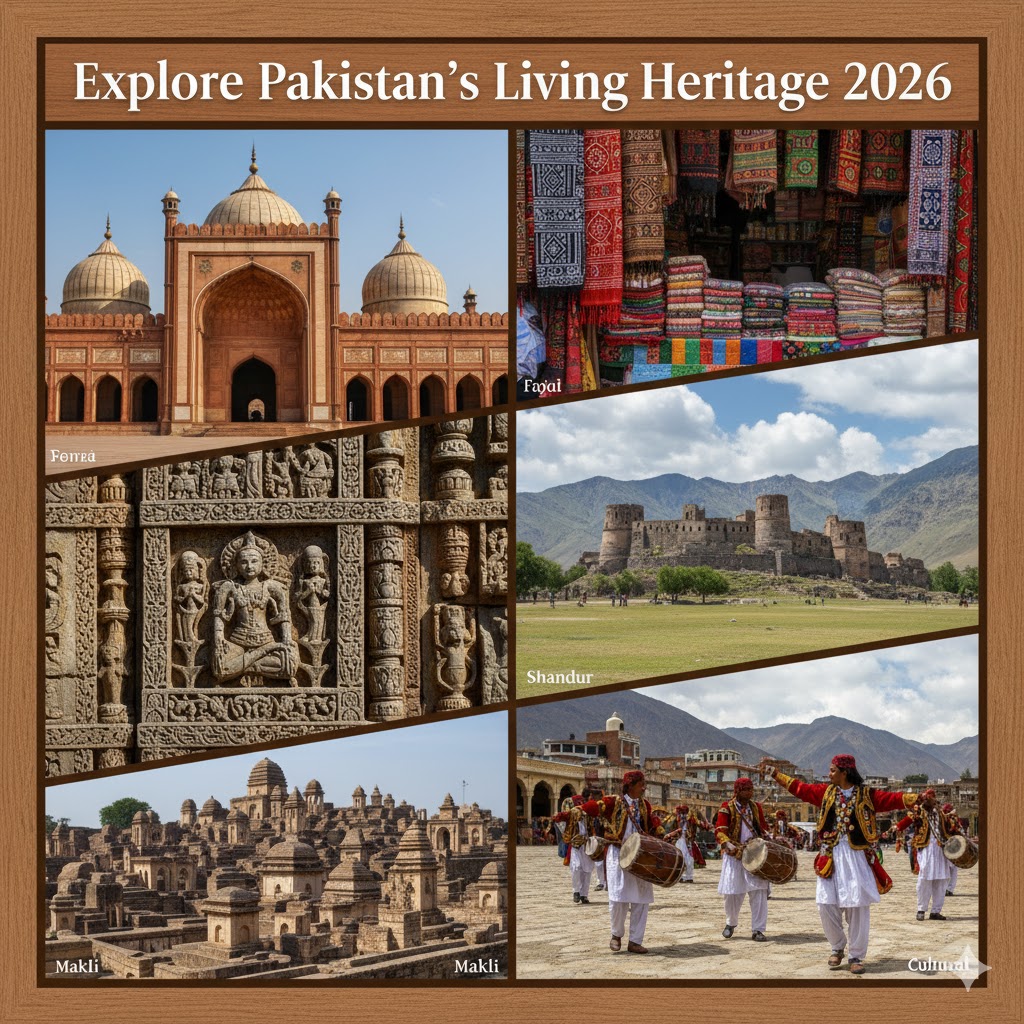
Introduction: The Soul of Pakistan Lies in Its Heritage
When you travel across Pakistan, you’re not just crossing mountains or deserts — you’re walking through the corridors of time. From the roaring Indus to the silent Himalayan valleys, every region holds fragments of civilizations that thrived thousands of years ago.
The heritage in Pakistan is more than bricks and stone — it’s a living memory of faith, art, and identity, where the stories of Mughal emperors, Buddhist monks, Sufi saints, and ancient traders intertwine like threads of an eternal tapestry.
Today, in 2026, as Pakistan opens its doors wider to cultural tourism, heritage trails are being rediscovered by both local explorers and international travelers. Whether you’re a history enthusiast, a photographer, or a cultural adventurer, Pakistan offers a breathtaking window into its past — from Multan’s golden shrines to Hunza’s stone forts, and from Mohenjo-Daro’s ruins to Takht-i-Bahi’s monasteries.
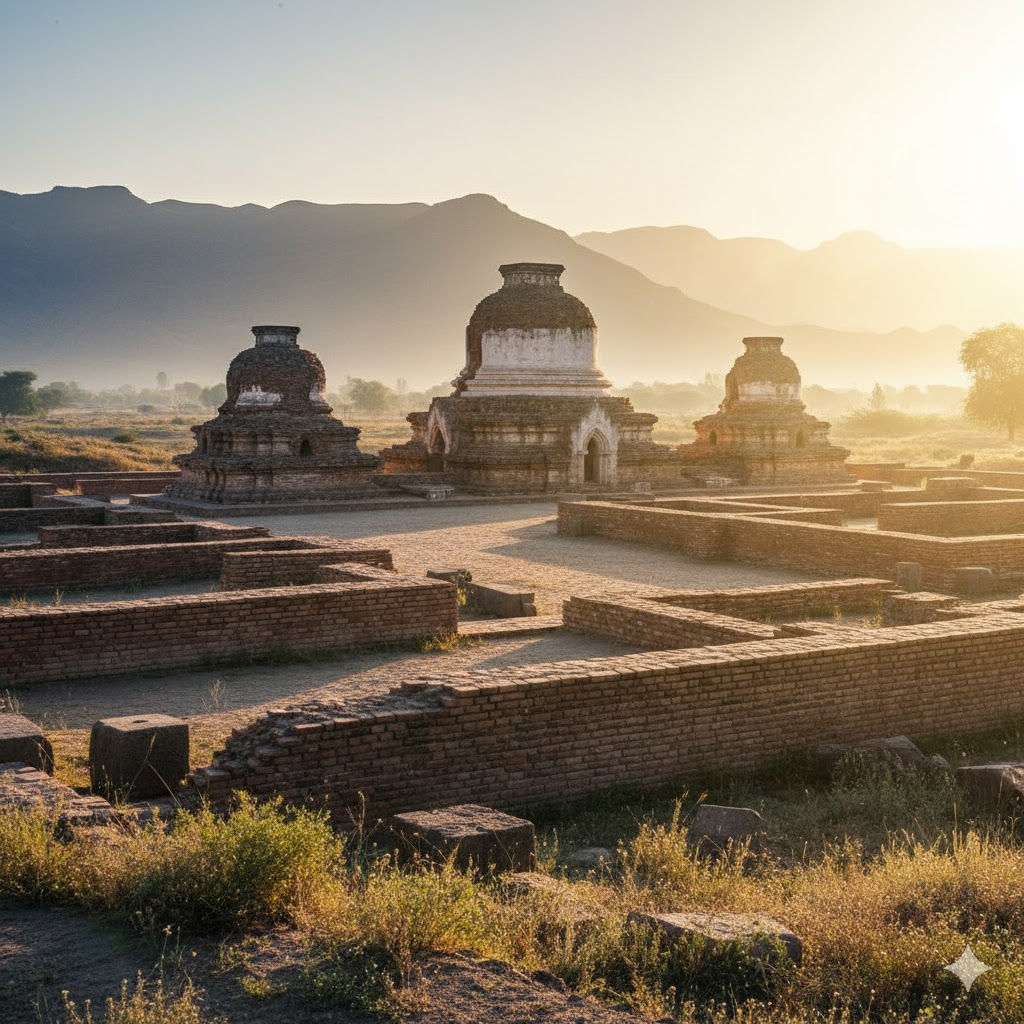
🕌 Punjab — Land of Palaces, Forts & Sufi Shrines
Punjab, the “Land of Five Rivers,” is the beating heart of Pakistan’s cultural identity. It has witnessed empires rise and fall — from the Indus Valley to the Mughals, from Sikh Maharajas to the British Raj. Every city, every street, echoes with heritage — preserved in forts, mosques, havelis, and shrines.
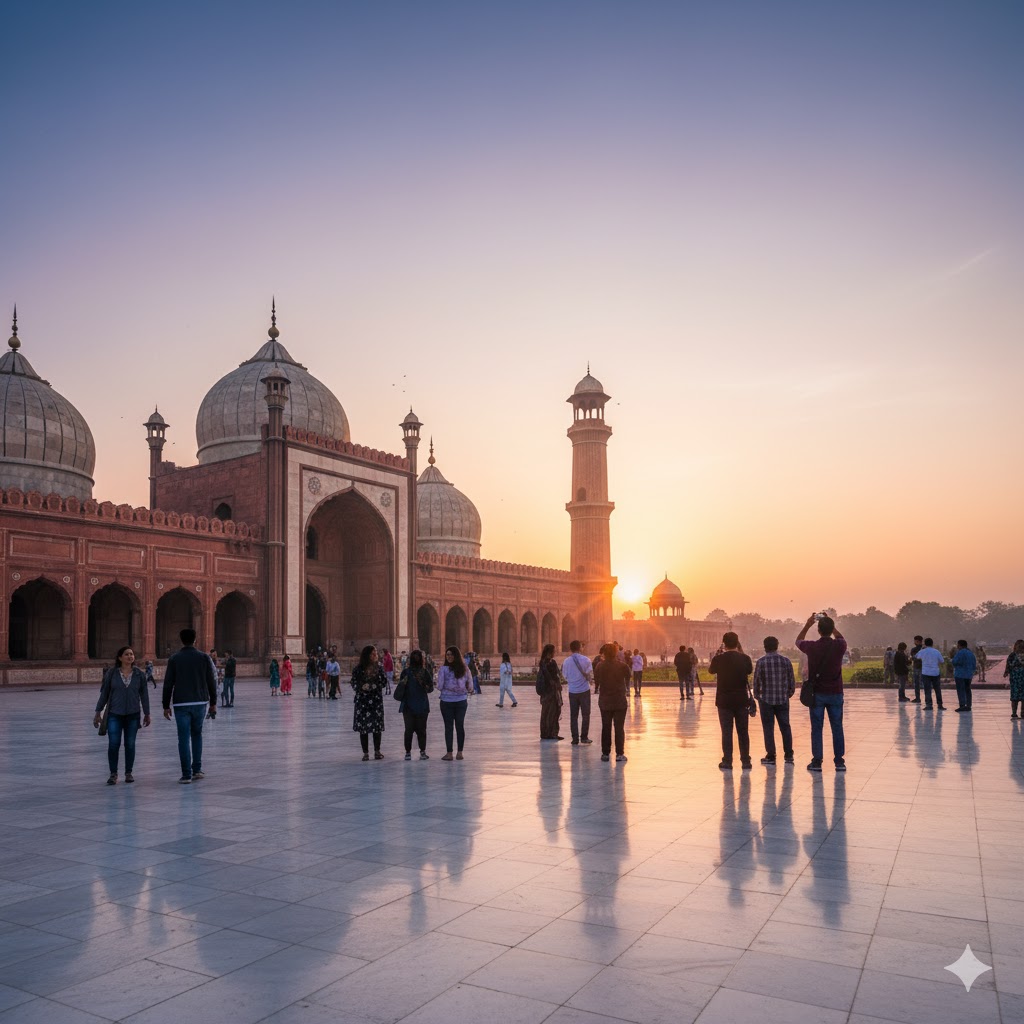
🏰 1. Lahore Fort & Shalimar Gardens — The Mughal Legacy
No exploration of Punjab’s heritage is complete without Lahore. The Lahore Fort, a UNESCO World Heritage Site, is a marvel of Mughal architecture, built during Emperor Akbar’s reign. Its shimmering Sheesh Mahal (Palace of Mirrors) reflects the artistic brilliance of the Mughal court, while the towering Alamgiri Gate opens to the iconic Badshahi Mosque, built by Aurangzeb.
A short drive away, the Shalimar Gardens bloom with cascading fountains and intricate Persian-style terraces — the Mughals’ love for paradise on earth captured in geometry and water.
Local Tip: Visit in the late afternoon for golden-hour photography. Entry tickets for foreigners are around PKR 1000 (~$3.50), locals PKR 50.
Hidden Gem: Inside the Fort, seek the lesser-known Picture Wall — a 400-meter mural with intricate tile work often missed by tourists.
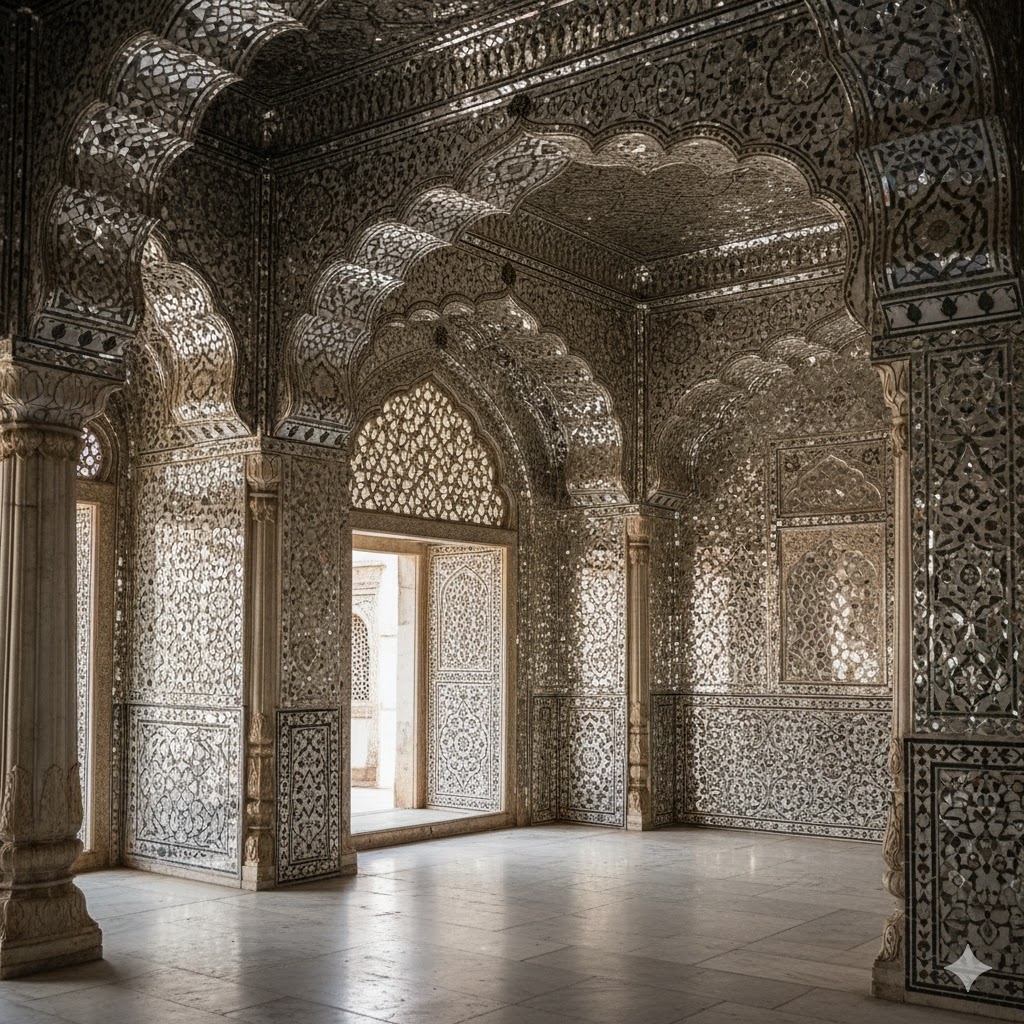
Must Visit: Top Tourist Events in Pakistan 2026: Best Cultural Festivals
Source: UNESCO Lahore Fort Listing
🌸 2. Multan — The City of Saints
Multan, one of the world’s oldest cities, is an open-air museum of spirituality. Known as the City of Saints, it boasts centuries-old Sufi shrines, bustling bazaars, and blue-tiled mausoleums.
The Shrine of Shah Rukn-e-Alam, an architectural masterpiece of pre-Mughal design, stands tall over the city skyline — a blend of devotion, symmetry, and turquoise majolica tiles.
Tradition & Highlights: Pilgrims visit year-round, tying ribbons and lighting oil lamps in prayer. The annual Urs Festival celebrates the saint’s legacy with qawwali music and food fairs.
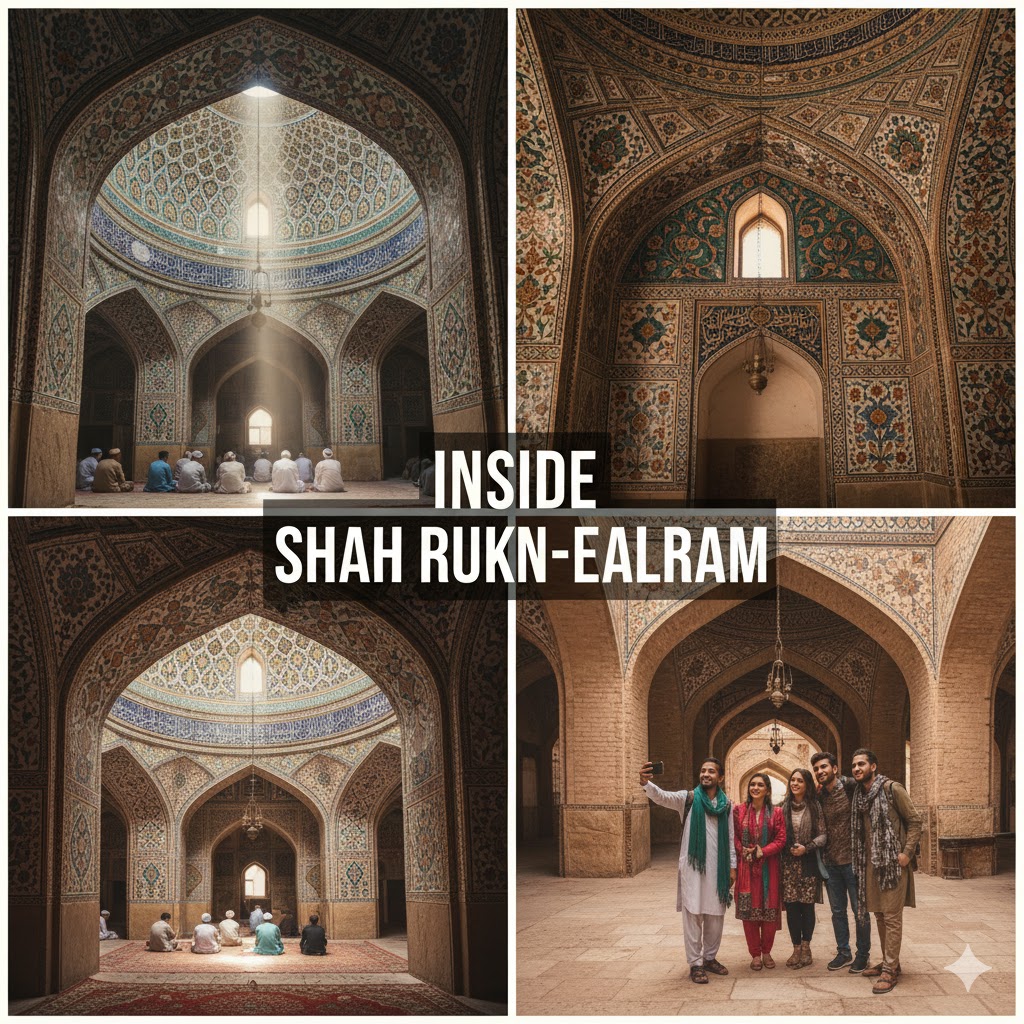
Hidden Gem: Seek out the Bahauddin Zakariya Shrine, surrounded by spice markets and narrow alleys rich in the aroma of roses and sandalwood.
Ticket Info: Entry is free, but donations are appreciated at the shrines. Dress modestly, and avoid photography during prayers.
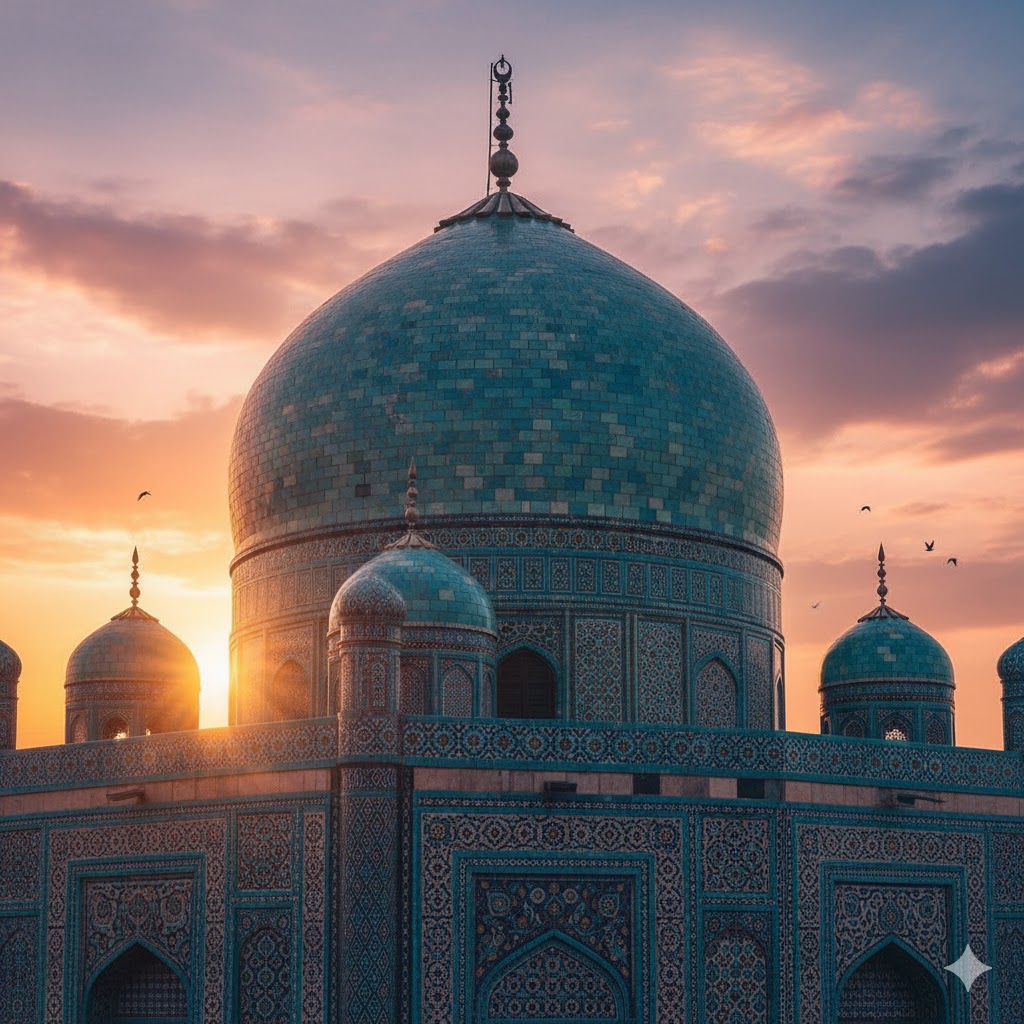
Must See: Silk Road Heritage Pakistan 2025: Forgotten Buddhist Trails
Source: Pakistan Tourism Development Corporation – Multan Heritage
🕊️ 3. Derawar Fort & Cholistan Desert — Echoes of the Bahawalpur State
Rising like a mirage in the sands of Cholistan, Derawar Fort is one of Pakistan’s most awe-inspiring heritage landmarks. Built in the 9th century and expanded by Nawab Sadiq of Bahawalpur, its forty bastions stand as sentinels of history.
Each brick whispers stories of caravan traders, desert kings, and forgotten kingdoms.
Tradition: The surrounding Cholistan Desert hosts the famous Jeep Rally every February — a fusion of sport, heritage, and local hospitality where thousands gather near the fort.
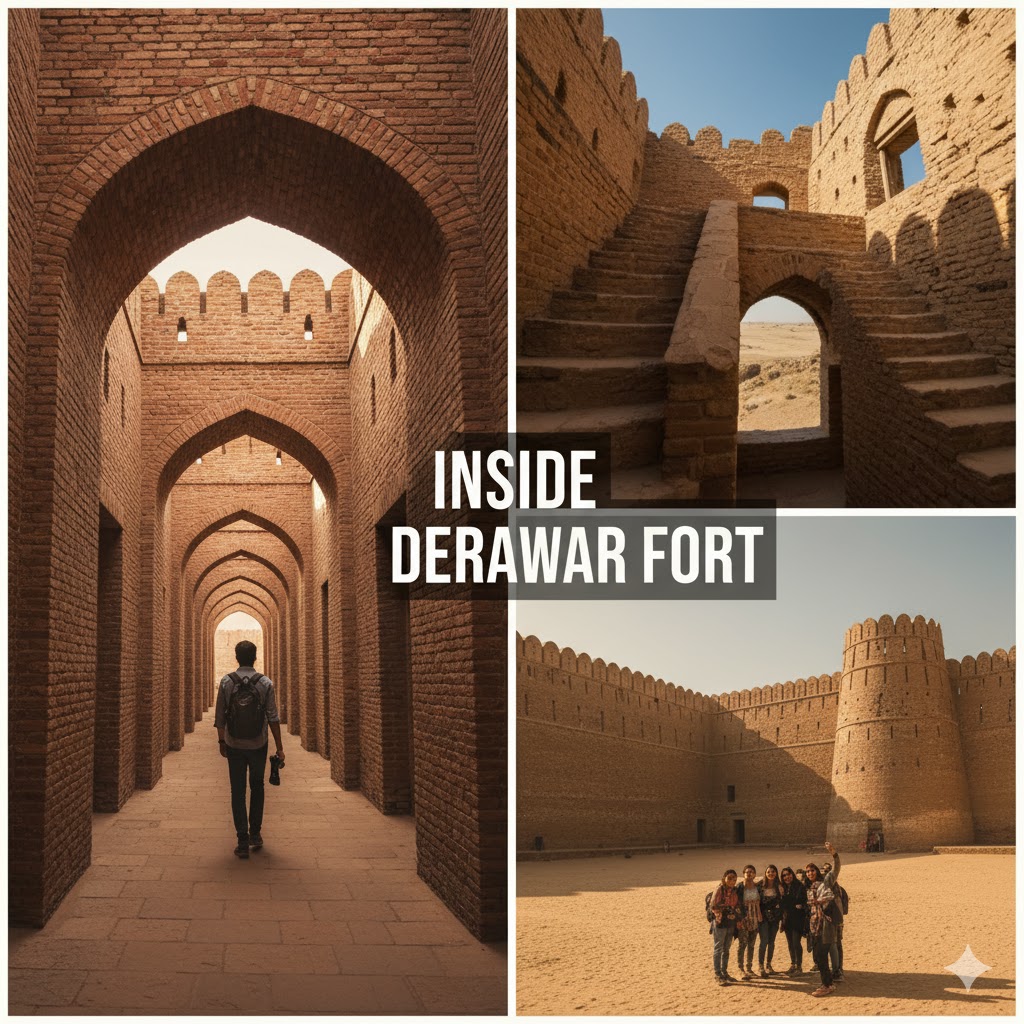
Local Tip: Visit at sunrise for golden hues across the dunes. Camping nearby offers stargazing like nowhere else.
Hidden Gem: The Abbasi Mosque near the fort — a pure white marble gem built in Nawab style — is often overlooked.
Entry: PKR 200 for locals, PKR 1000 for foreigners. Guided tours by locals are available for a small tip.
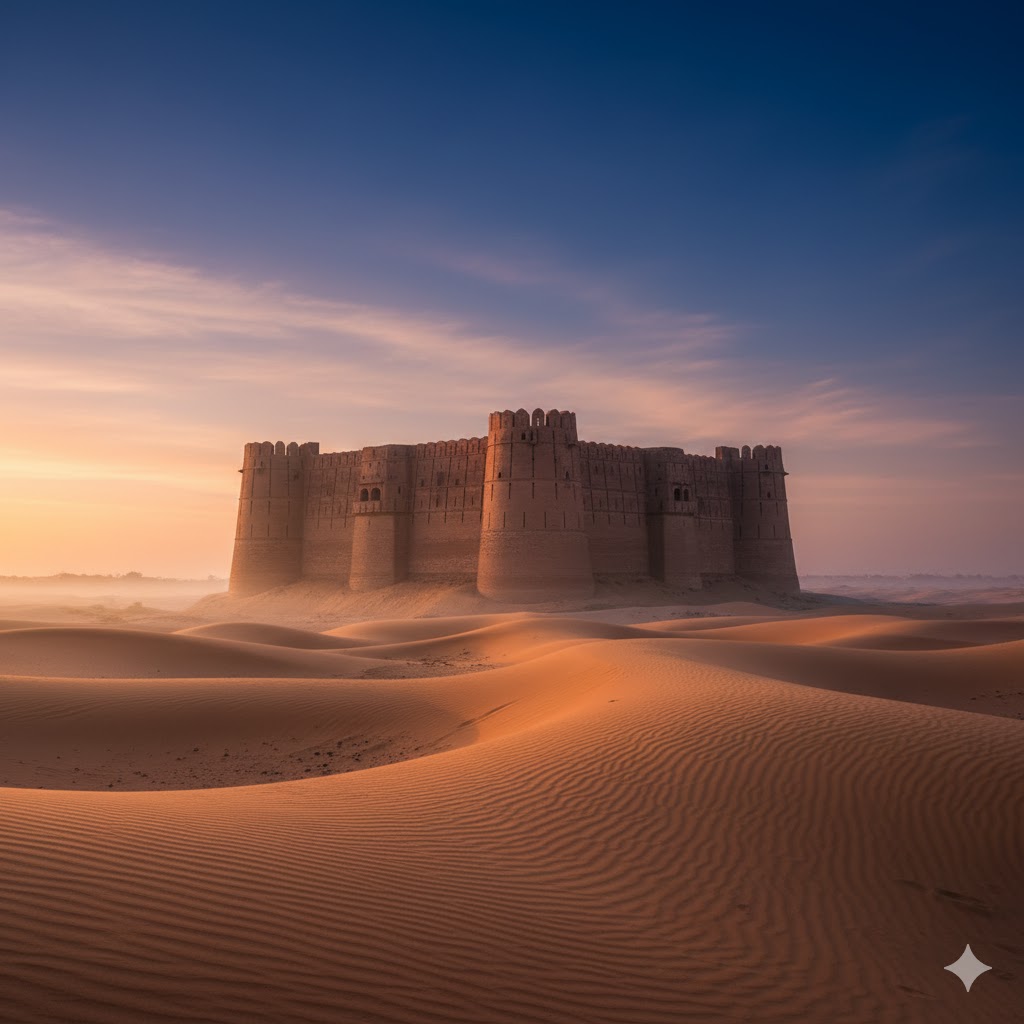
Source: Cholistan Jeep Rally Info
🏯 4. Harappa — Cradle of Ancient Civilization
Long before the Mughals, the Indus Valley Civilization flourished here. Harappa, located near Sahiwal, dates back over 5000 years. Excavations reveal streets with advanced drainage systems, pottery workshops, and granaries — proof of a highly organized society.
Tradition & Highlights: The museum displays artifacts such as terracotta figurines, seals, and jewelry. Archaeologists continue to discover new insights into early urban life.
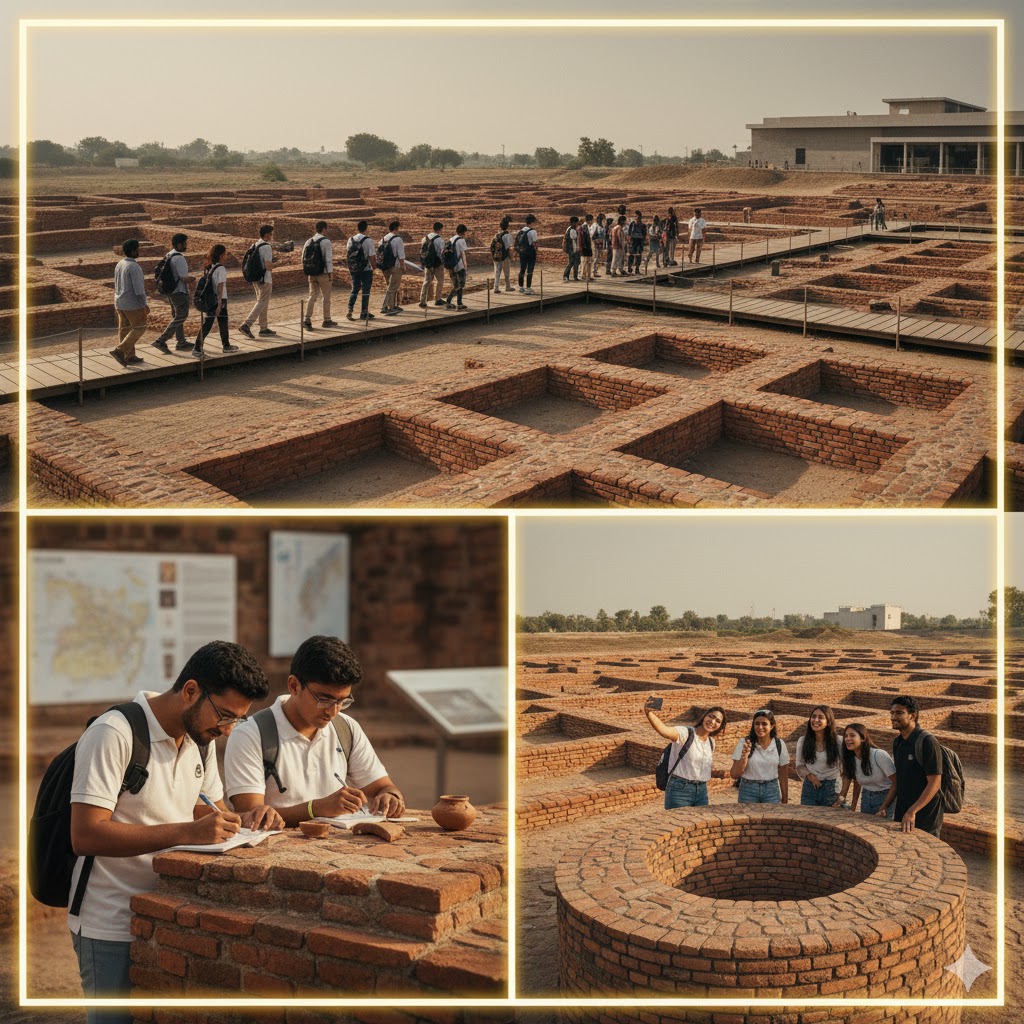
Hidden Gem: Visit the nearby village of Harappa to meet local artisans who still create pottery inspired by ancient designs.
Entry Fee: PKR 500 for foreigners, PKR 50 for locals.
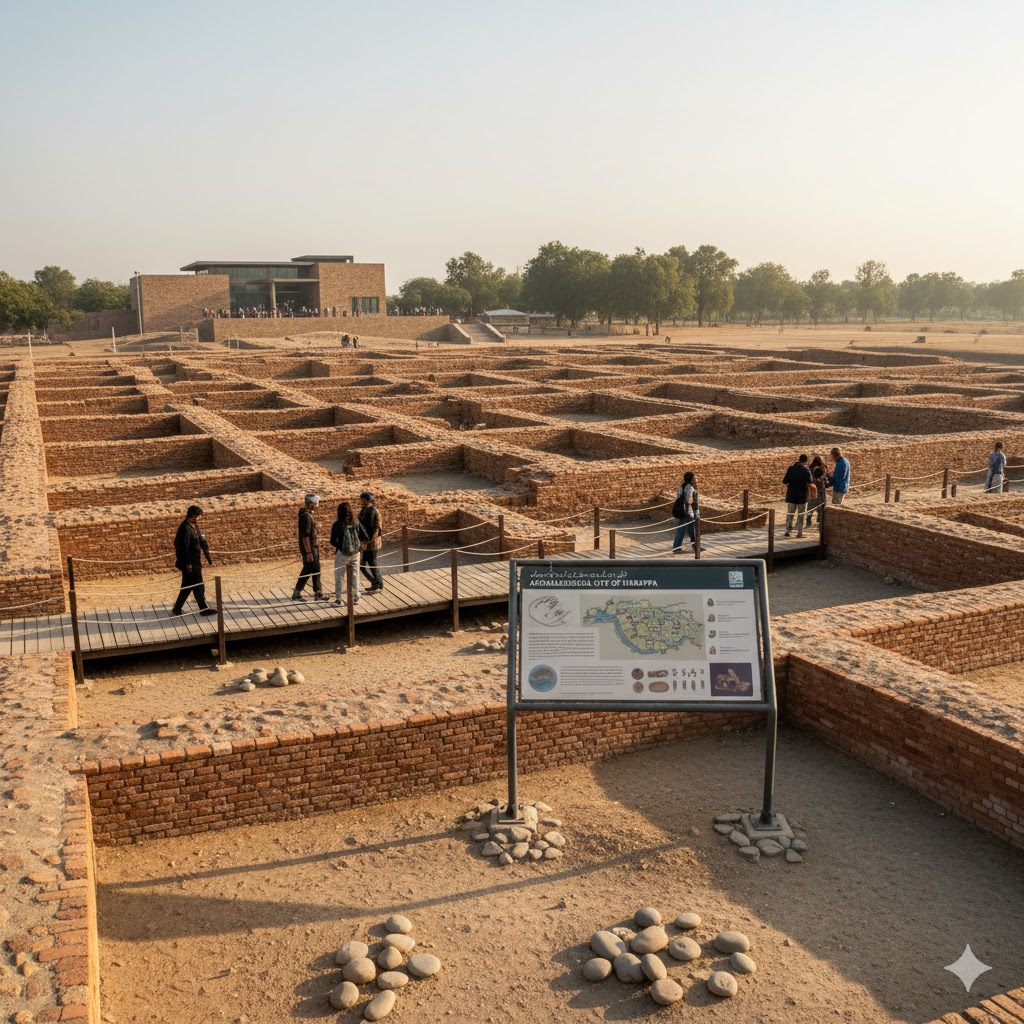
🎨 5. Bahawalpur — Royal Heritage & Palatial Grandeur
Once a princely state, Bahawalpur shines with royal heritage. The Noor Mahal, a magnificent Italian-style palace built in 1872, mirrors colonial elegance.
Nearby, Sadiq Garh Palace — though closed to the public for restoration — remains an icon of opulence. The city’s architecture blends European neoclassicism with Islamic motifs, showing how Bahawalpur’s Nawabs integrated global styles into local tradition.
Local Tip: Visit the Bahawalpur Museum for exhibits on the Nawabs’ legacy and Cholistan artifacts.
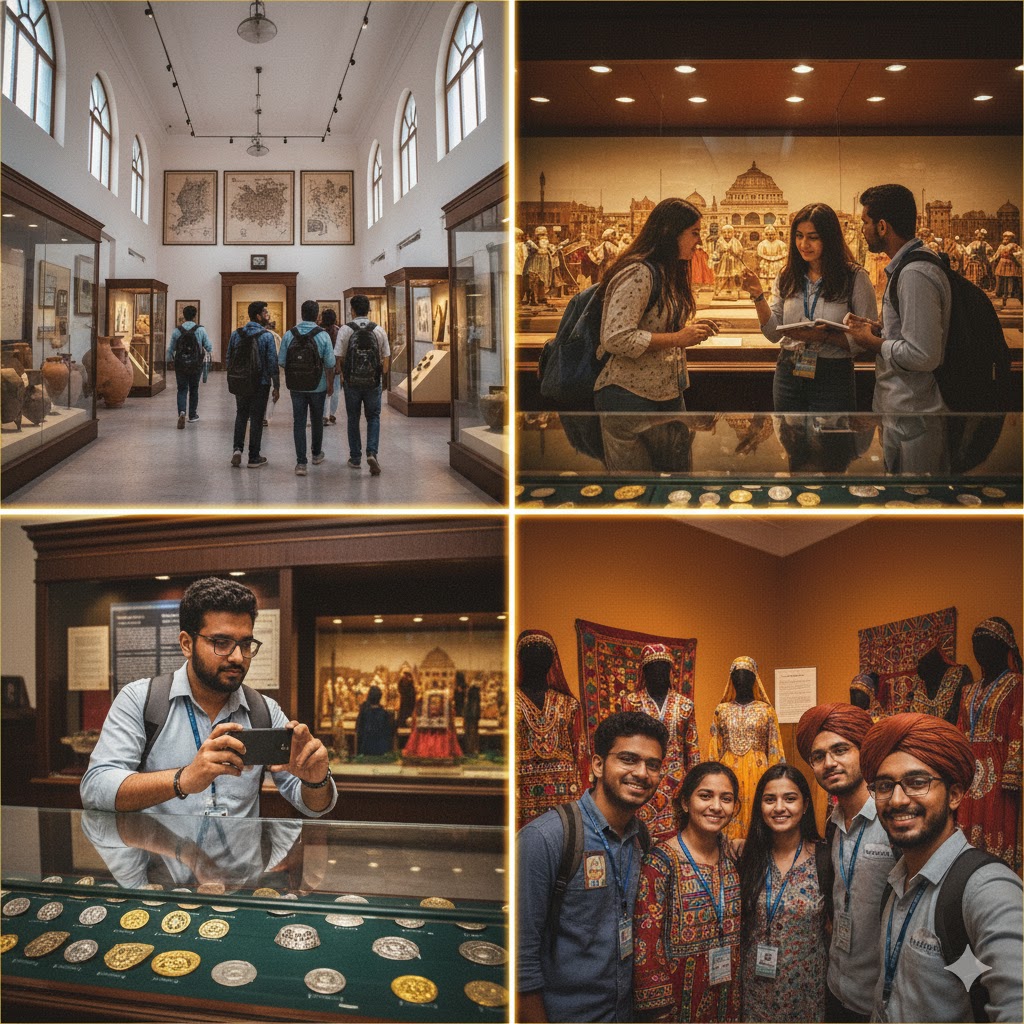
Hidden Gem: The lesser-known Darbar Mahal, known for its red-brick Rajputana design, perfect for photographers.
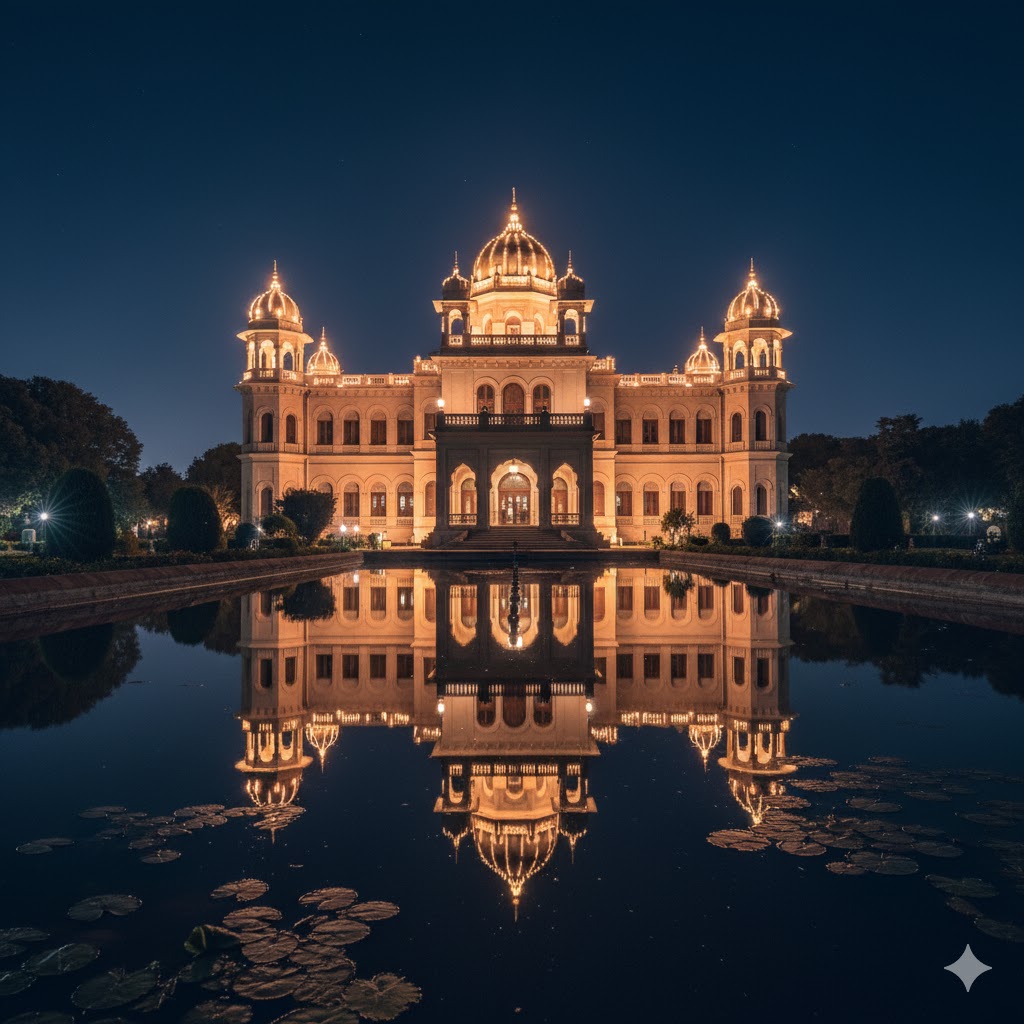
Source: TDCP Bahawalpur Heritage Sites
💫 Cultural Snapshot of Punjab (2026)
| Region | Key Heritage Site | Highlight | Entry Fee | Best Time to Visit |
|---|---|---|---|---|
| Lahore | Lahore Fort | Mughal architecture, Sheesh Mahal | PKR 1000 | Oct–Mar |
| Multan | Shah Rukn-e-Alam Shrine | Sufi heritage | Free | Nov–Feb |
| Bahawalpur | Noor Mahal | Nawabi architecture | PKR 500 | Dec–Mar |
| Harappa | Indus Ruins | Ancient civilization | PKR 500 | Oct–Feb |
| Cholistan | Derawar Fort | Desert Fort & Rally | PKR 200 | Feb (Jeep Rally) |
Sindh — The Cradle of Indus Civilization and Sufi Soul of Pakistan
Sindh is where Pakistan’s recorded history truly begins. It’s the land where the Indus Valley Civilization blossomed 5,000 years ago and where Islam first entered South Asia through the port of Debal. Every inch of Sindh — from its arid deserts to its coastal towns — echoes with legends of saints, sailors, and poets.
Its cultural fabric weaves together Sufi mysticism, ancient trade routes, and artistic craftsmanship that still thrives in every market and village.
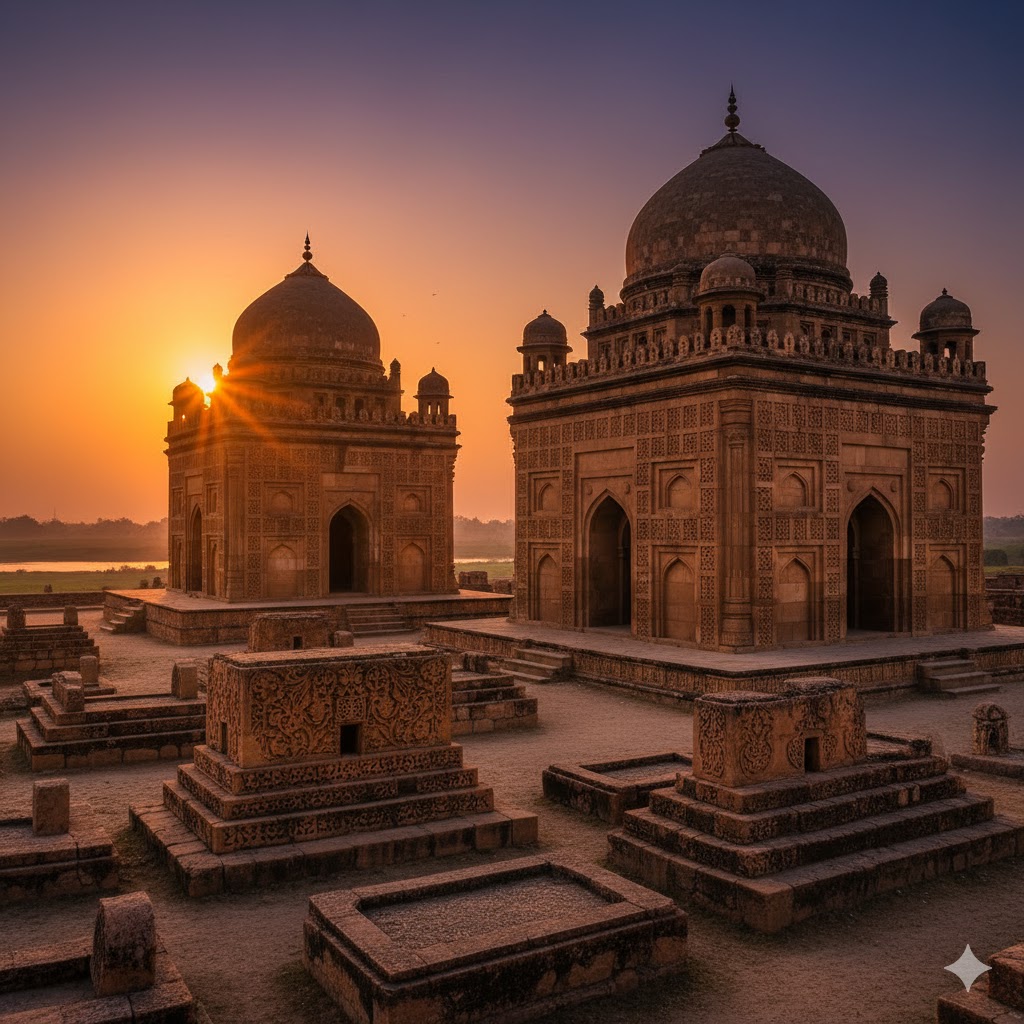
🏛️ 1. Mohenjo-Daro — Birthplace of Urban Civilization
Known as the “Mound of the Dead,” Mohenjo-Daro is one of the most important archaeological discoveries of the 20th century — a UNESCO World Heritage Site that reveals the brilliance of the Indus Valley Civilization (2600 BCE).
Visitors can still see the city’s grid layout, advanced drainage systems, public baths, and brick-lined streets — all designed long before modern cities existed.
Tradition & Highlights: Each year, archaeologists, students, and history enthusiasts gather for the Indus Cultural Festival, showcasing ancient craft revival, pottery exhibitions, and heritage awareness campaigns.
Hidden Gem: The Great Bath, carved from baked bricks and waterproofed with bitumen, is believed to have been used for ritual purification — a reflection of the spiritual sophistication of this ancient culture.
Local Tip: Visit early morning for the best light and cooler weather. The on-site museum holds seals, jewelry, and tools that provide context to what was once a flourishing society.
Entry Fee: PKR 1000 for foreigners, PKR 100 for locals.

Source: UNESCO Mohenjo-Daro Heritage Site
Must See: Discover Travel Spots Near Islamabad 2026 Hidden Gems
🕊️ 2. Makli Necropolis — The Silent City of Saints
On the outskirts of Thatta lies the Makli Necropolis, one of the largest funerary sites in the world, stretching across 10 square kilometers. Housing nearly half a million tombs, it represents four centuries of Sindhi history.
Tradition & Highlights: Each tomb tells a different story — from kings to scholars, poets, and Sufi saints. The intricate sandstone carvings, glazed tiles, and Persian calligraphy depict a blend of Islamic, Hindu, and Central Asian art styles.
Hidden Gem: The tomb of Jam Nizamuddin II features the region’s most exquisite tile work, blending turquoise and mustard hues in symmetrical perfection.
Local Tip: Hire a local guide from Thatta — they often share folklore about the buried saints and their miracles.
Ticket Info: PKR 200 for locals, PKR 800 for foreigners. Open sunrise to sunset.
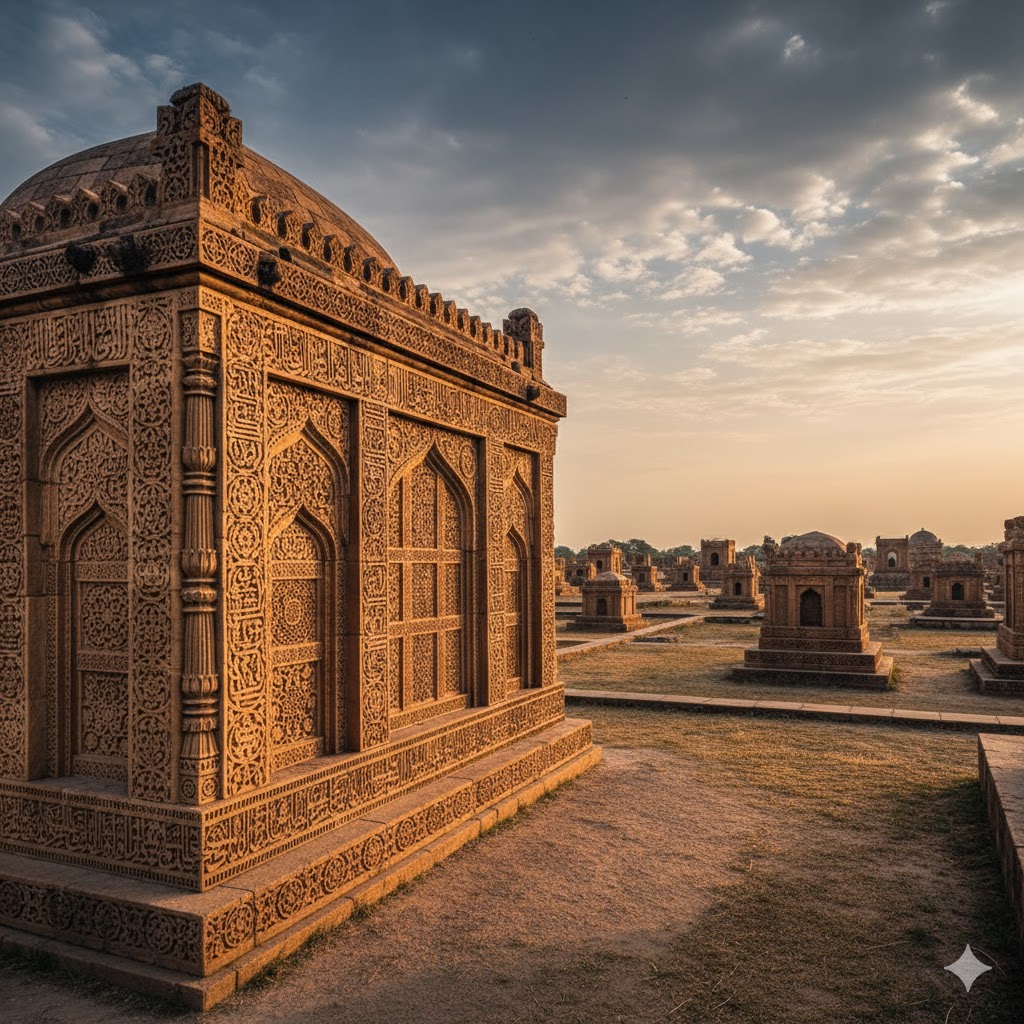
Source: Makli Necropolis – UNESCO Heritage Listing
🌊 3. Shah Jahan Mosque, Thatta — The Mosque of 93 Domes
Built by Mughal Emperor Shah Jahan in the 17th century, this mosque is a masterpiece of acoustic and geometric engineering. Known as the “Mosque of 93 Domes,” it was gifted by the emperor to the people of Thatta.
The interior walls are covered in red and blue tiles imported from Hala, while its domed ceilings echo a perfect sound reflection — allowing an Imam’s voice to travel naturally without amplification.
Tradition: Locals believe each dome represents a prayer answered, and many travelers meditate here for spiritual clarity.
Hidden Gem: Stand under the central dome and recite softly — your voice will resonate beautifully through the entire hall.
Entry Fee: Free entry; respectful attire required.
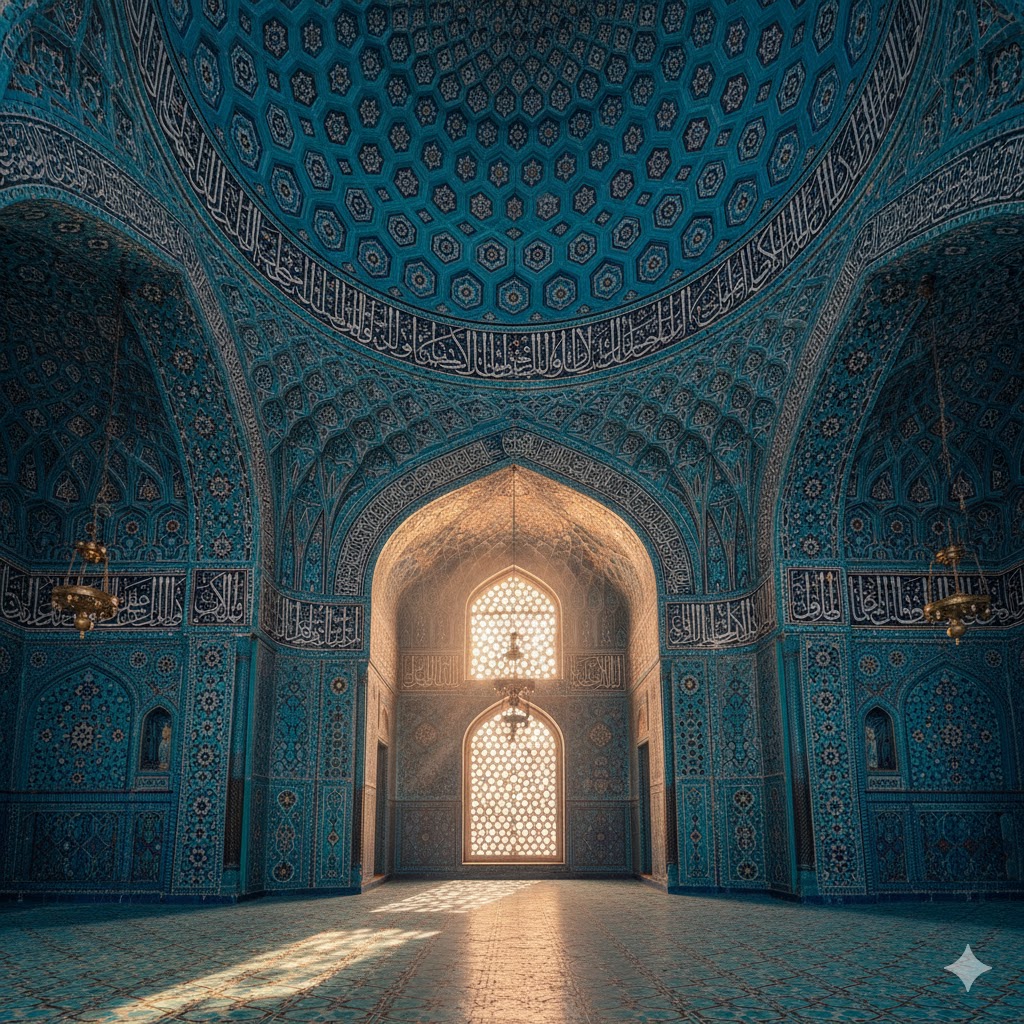
Must See: Best Life in the Mountains Pakistan 2026: Adventure Trails
🎶 4. Bhit Shah — Shrine of Shah Abdul Latif Bhittai
The heart of Sindh beats in Bhit Shah, home of the revered Sufi poet Shah Abdul Latif Bhittai (1689–1752). His poetry, compiled in the Shah Jo Risalo, celebrates love, unity, and human dignity.
The shrine is not only a spiritual center but also a hub for Sindhi music and folklore.
Tradition & Highlights: Every Thursday evening, Sufi singers perform Bhittai’s verses with the tambura, creating a soulful atmosphere that attracts both devotees and tourists.
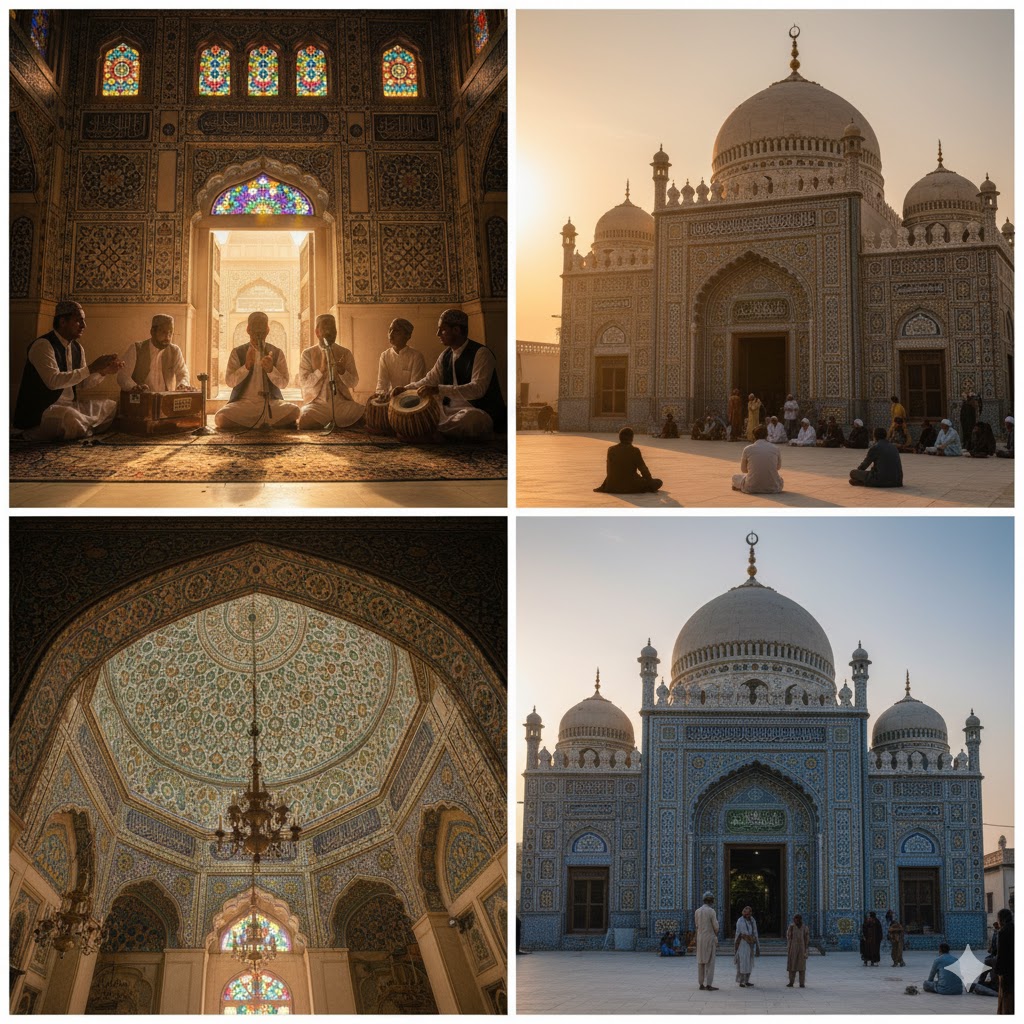
Hidden Gem: The annual Urs festival, held every Safar (Islamic month), features local crafts, camel rides, storytelling nights, and the rhythmic beat of dhol drums echoing through the desert air.
Local Tip: Bring a small gift — like flowers or sweets — as a gesture of respect when visiting the shrine.
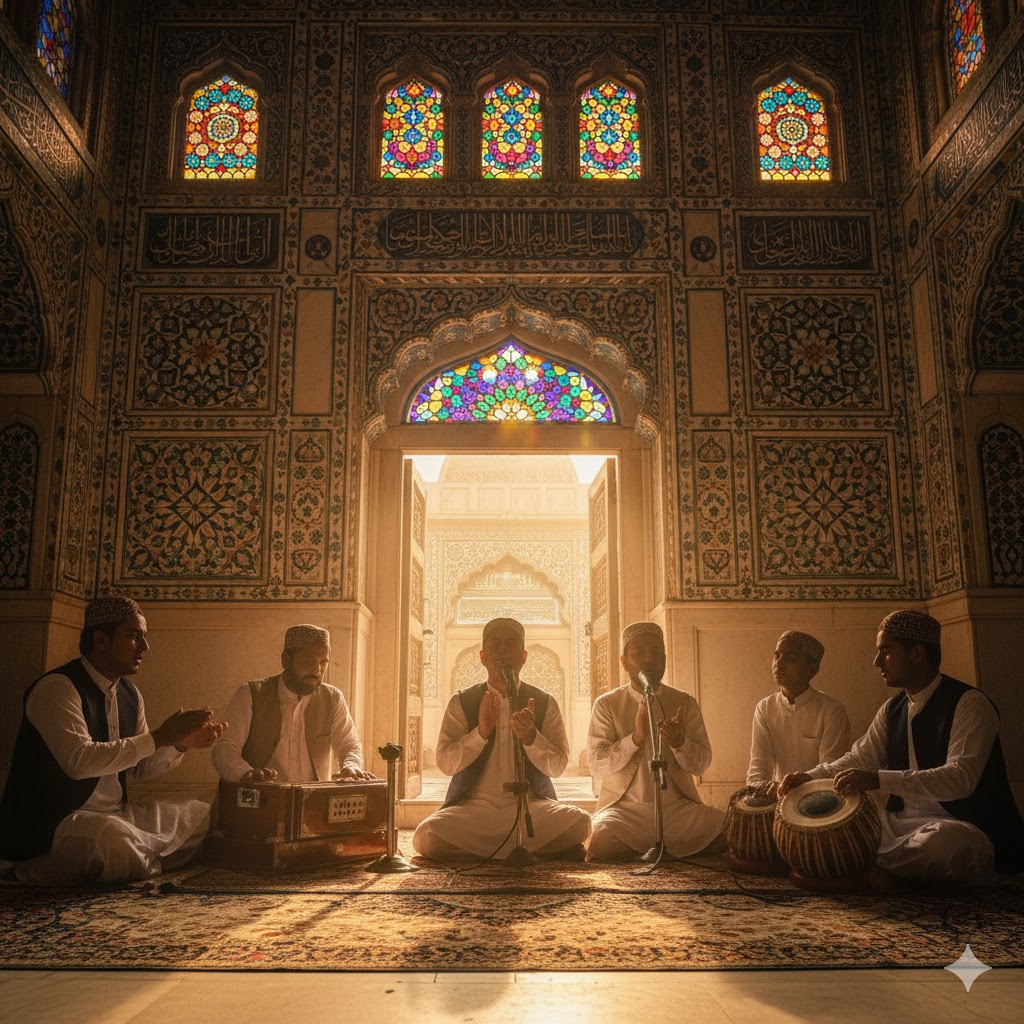
Source: Sindh Tourism Bhit Shah Shrine
🐪 5. Ranikot Fort — The Great Wall of Sindh
Often called the “Great Wall of Pakistan,” Ranikot Fort is the largest fort in the world, stretching over 30 kilometers through the rugged hills of the Kirthar Range.
Historians believe it dates back to the Sassanian or Talpur era, though its true origin remains a mystery.
Tradition & Highlights: Hikers and photographers love Ranikot for its panoramic landscapes, wildflowers, and the calm silence of its stone bastions.
Hidden Gem: The Meerikot Fort, located within Ranikot’s inner walls, provides the best sunrise view across Sindh’s rocky terrain.
Local Tip: Visit in winter (Nov–Feb). Bring hiking shoes, sunblock, and water — facilities are limited.
Entry Fee: PKR 500 for foreigners, PKR 100 for locals.
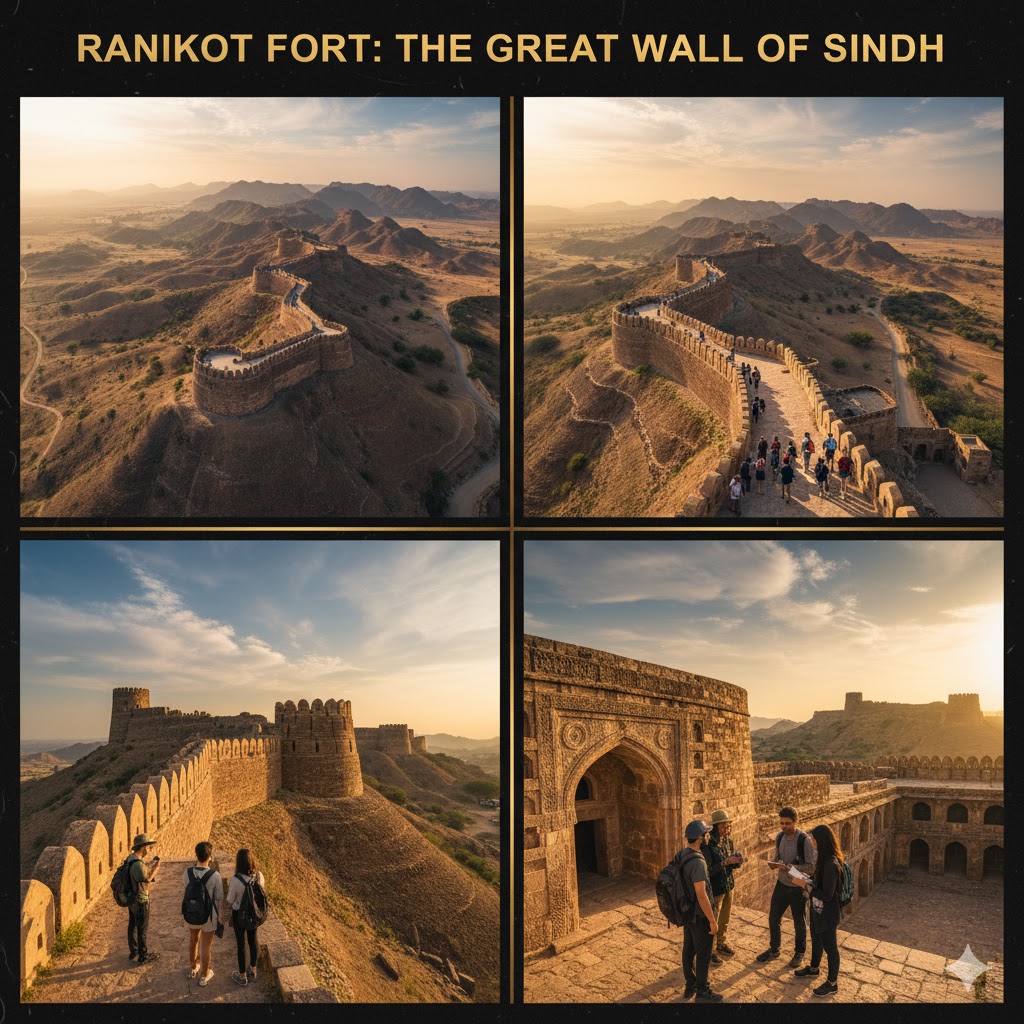
Source: Ranikot Fort Hiking and Heritage Info
🏺 6. Hala & Nasarpur — Craft Villages of Sindh
The artistic heritage of Sindh lives on in the villages of Hala and Nasarpur, where artisans still handcraft pottery, Ajrak prints, and glazed tiles.
These crafts trace their roots to the Indus Valley artisans of ancient times — each design telling stories of the land and its people.
Tradition & Highlights: Watch Ajrak printers dye cloths using natural indigo and madder root. Potters craft vases with sun-baked perfection, and women artisans embroider Sindhi caps in bright reds and blues.
Hidden Gem: Visit the Khudabad Shrine, nearby, adorned with intricate tile mosaics similar to those of Makli.
Local Tip: Support local cooperatives — authentic Ajraks cost around PKR 2500–4000 ($9–12). Avoid mass-produced imitations in urban markets.
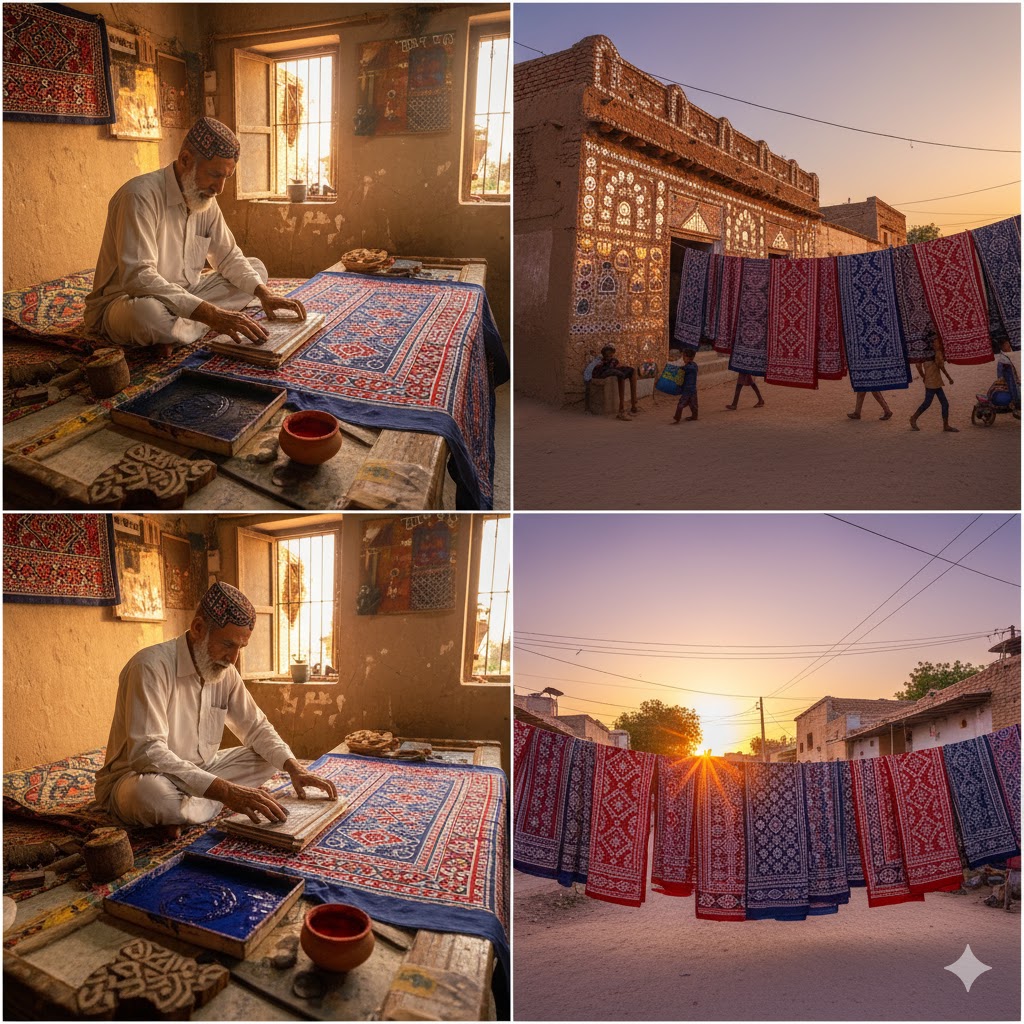
🌴 7. Karachi — Colonial Heritage Meets Modern Identity
Karachi, Pakistan’s largest city, is not just a commercial hub — it’s a museum of colonial and modern heritage. From Frere Hall to Mohatta Palace, the city preserves British and early Pakistani architecture amid modern chaos.
Tradition & Highlights:
- Mohatta Palace (built in 1927): once a Hindu merchant’s residence, now an art gallery.
- Empress Market: a colonial-era structure still serving locals with spices, antiques, and textiles.
- Quaid-e-Azam’s Mausoleum (Mazar-e-Quaid): a marble icon representing Pakistan’s independence movement.
Hidden Gem: The TDF Ghar, a restored 1930s house-turned-cultural café near Burns Road, offers heritage tea and vintage exhibits.
Local Tip: Visit Frere Hall on Sundays — the book market and street artists bring colonial charm to life.
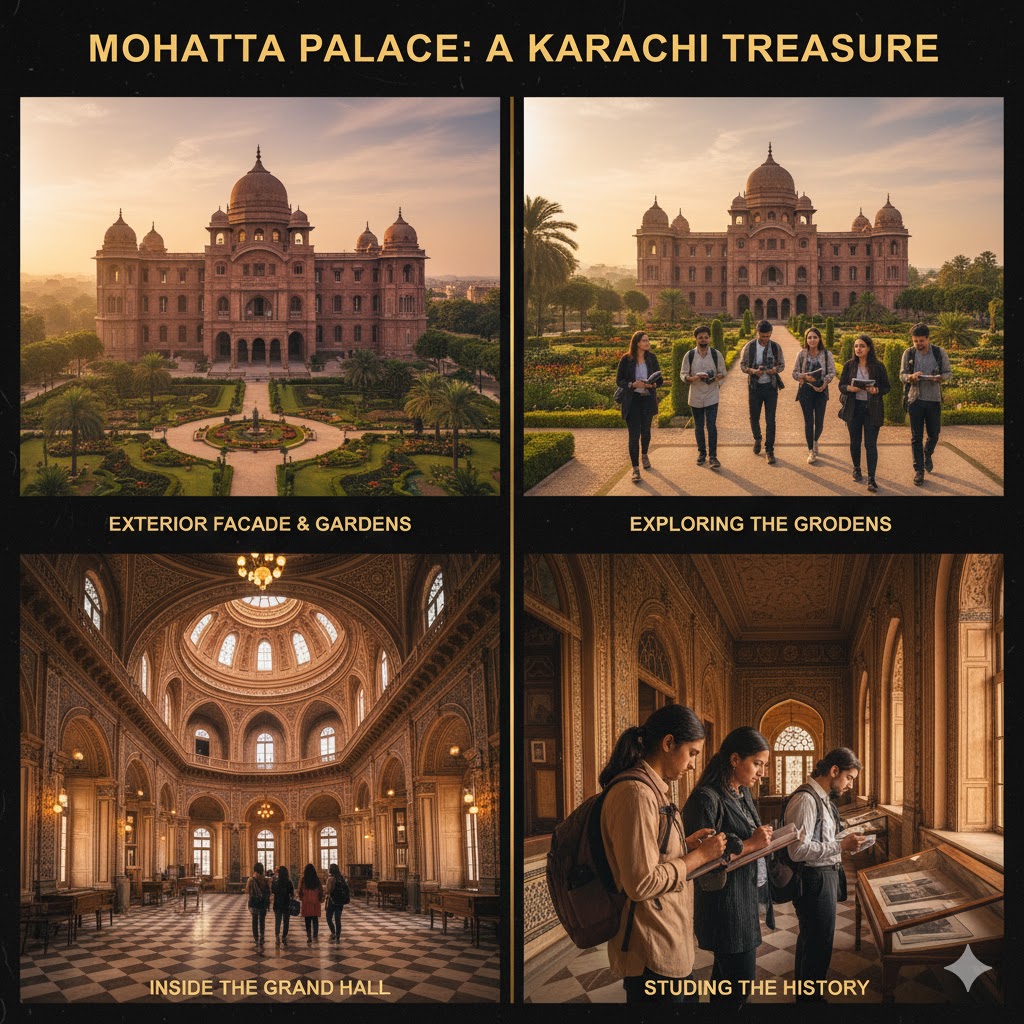
📊 Cultural Snapshot of Sindh (2026)
| Region | Key Heritage Site | Highlight | Entry Fee | Best Time to Visit |
|---|---|---|---|---|
| Mohenjo-Daro | Indus Ruins | Ancient Civilization | PKR 1000 | Nov–Feb |
| Makli | Tomb Complex | Sindhi Architecture | PKR 800 | Oct–Mar |
| Bhit Shah | Shrine | Sufi Music & Poetry | Free | Year-round |
| Ranikot Fort | Ancient Wall | Trekking & Fort Views | PKR 500 | Nov–Feb |
| Karachi | Mohatta Palace | Colonial Art | PKR 300 | Dec–Mar |
🎨 Cultural Essence of Sindh
Sindh’s heritage is a poetic dialogue between faith and art. Its mosques, forts, and villages tell stories of unity and resilience. The melodies of Bhittai’s Risalo, the patterns of Ajrak, and the echoes of ancient brick cities make Sindh a timeless journey — a bridge connecting Pakistan’s past with its modern soul.
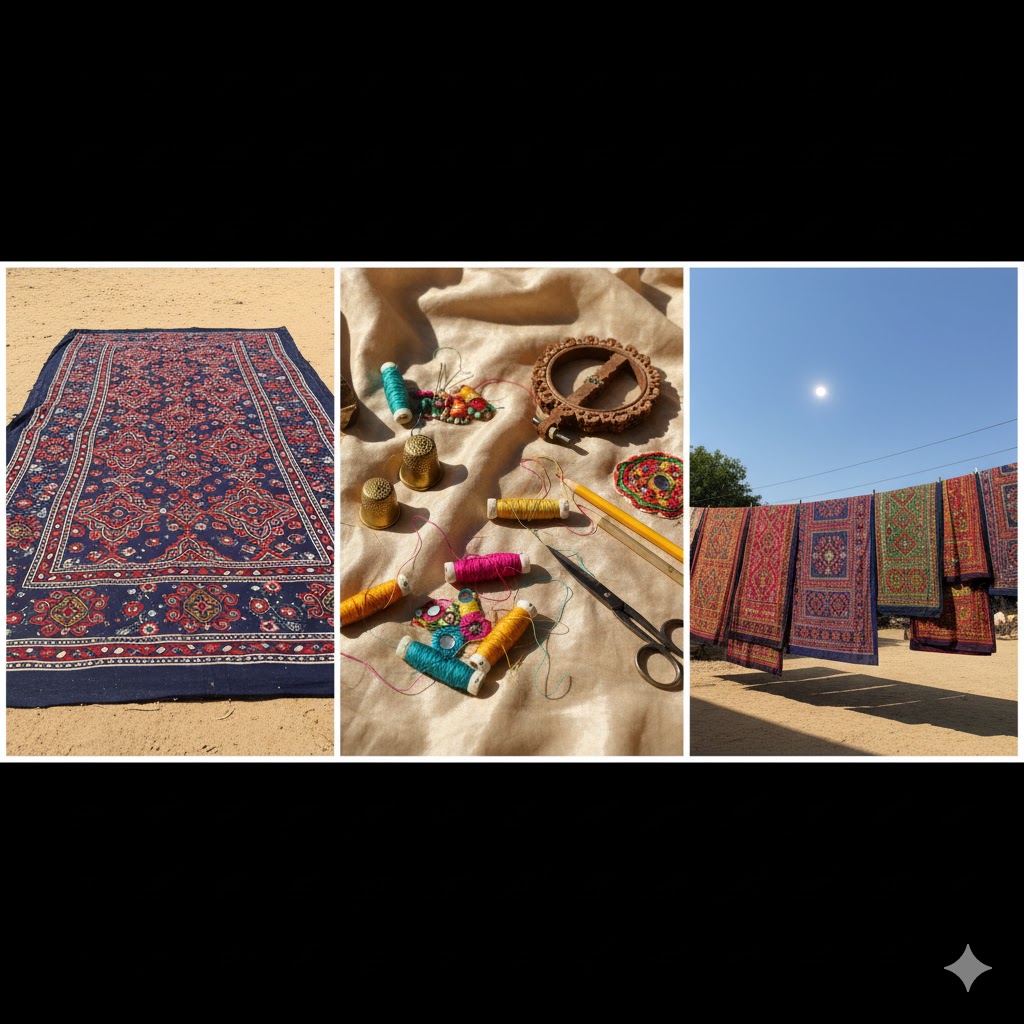
Khyber Pakhtunkhwa (KPK) — Valleys of Warriors and Ancient Kingdoms
Nestled between the mighty Hindu Kush and the rolling plains, Khyber Pakhtunkhwa (often called KP) is where adventure meets ancient spirituality. Once part of Gandhara Civilization, this region preserves Buddhist heritage, Islamic shrines, colonial relics, and tribal culture — all layered in its stunning valleys and rugged mountains.
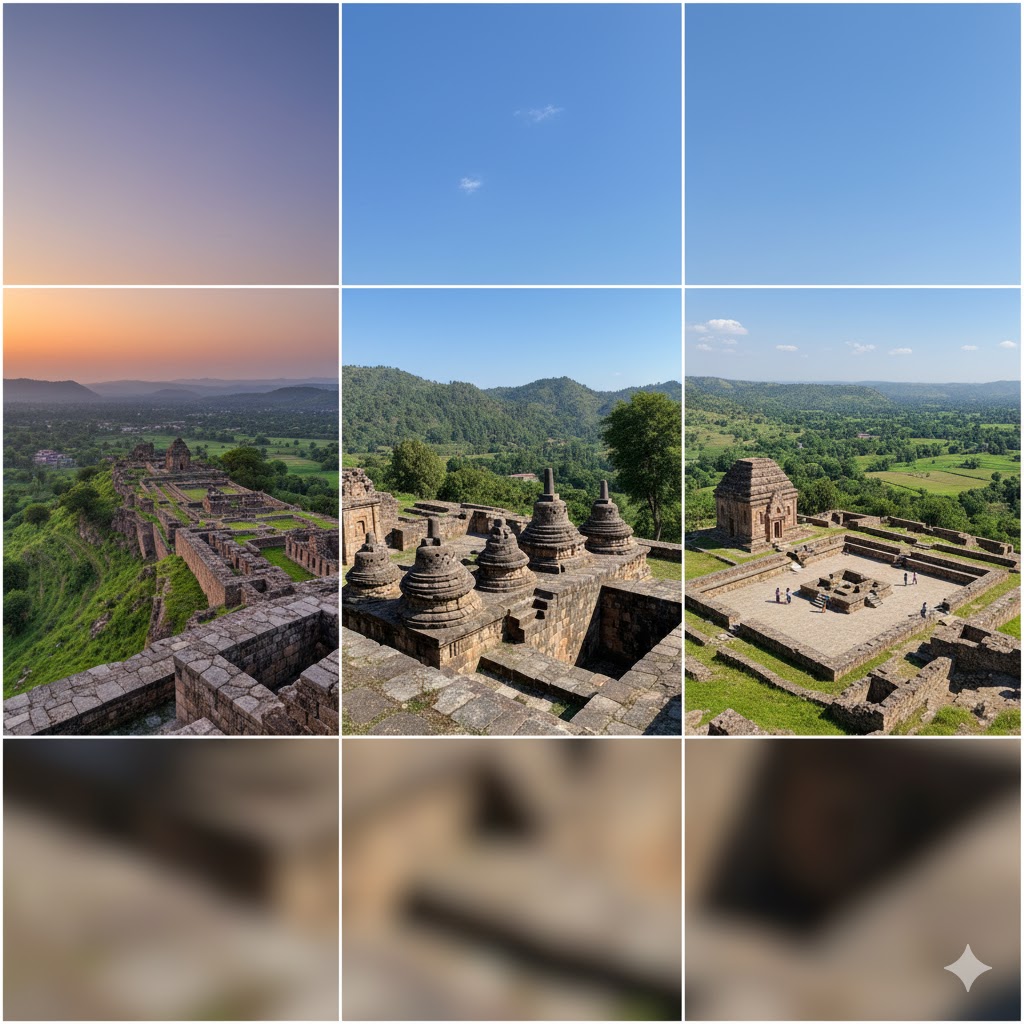
🕉️ 1. Takht-i-Bahi — The Monastery in the Clouds
Declared a UNESCO World Heritage Site, Takht-i-Bahi is one of the best-preserved Buddhist monasteries in Asia. Dating back to the 1st century BCE, it once served as a spiritual university for monks along the Gandhara Trail.
Tradition & Highlights: The stone courtyards, meditation cells, and stupas symbolize early Buddhist architecture and teaching traditions. Pilgrims from Sri Lanka, Japan, and Nepal still visit for meditation retreats.
Hidden Gem: The hilltop terrace offers a surreal sunrise view over Mardan’s plains — perfect for photographers and drone enthusiasts.
Local Tip: Arrive early morning or late evening; the temperature can soar midday. Bring water and a sun hat.
Entry Fee: PKR 500 (locals), PKR 1000 (foreigners).
Source: UNESCO Takht-i-Bahi Listing
Must See: Best College University Road Trip Northern 2026: Meadows Mountains
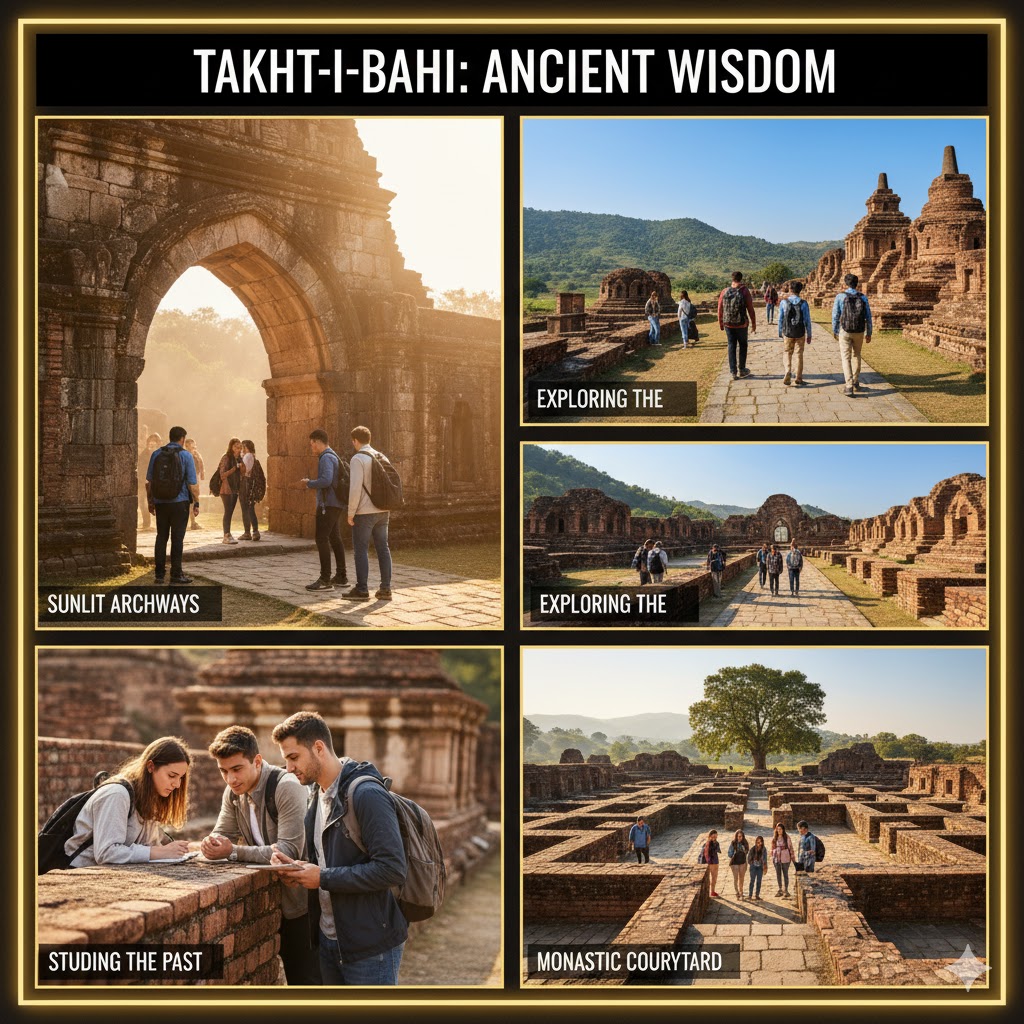
🕌 2. Sethi House — Peshawar’s Forgotten Jewel
Located in the heart of Peshawar’s Old City, the Sethi House reflects the grandeur of 19th-century trade families who connected Central Asia to British India through commerce. Built with intricate wooden balconies and colorful glass windows, it’s a living example of Kashmiri and Central Asian craftsmanship.
Tradition & Highlights: The courtyard design keeps the house cool year-round, while lattice work tells stories of Persian and Mughal influence.
Hidden Gem: The upper balcony offers an authentic view of old Peshawar life — narrow lanes, spice markets, and call to prayer echoing through ancient mosques.
Local Tip: Combine your visit with a stroll through Qissa Khwani Bazaar, also known as “Storytellers’ Market.”

Source: Khyber Pakhtunkhwa Tourism Department
🕌 3. Bala Hisar Fort — The Crown of Peshawar
Bala Hisar, meaning “High Fort,” stands atop a mound overseeing Peshawar. Originally built by the Kushan Empire, later rebuilt by Mughals and used by the Durrani rulers, it has witnessed centuries of invasions and victories.
Tradition & Highlights: It now serves as a military heritage site — showcasing historic weaponry, maps, and models of Peshawar’s evolution.
Hidden Gem: The watchtower view at sunset, when city lights meet mountain shadows.
Local Tip: Entry requires ID; dress modestly and respect photography restrictions inside.
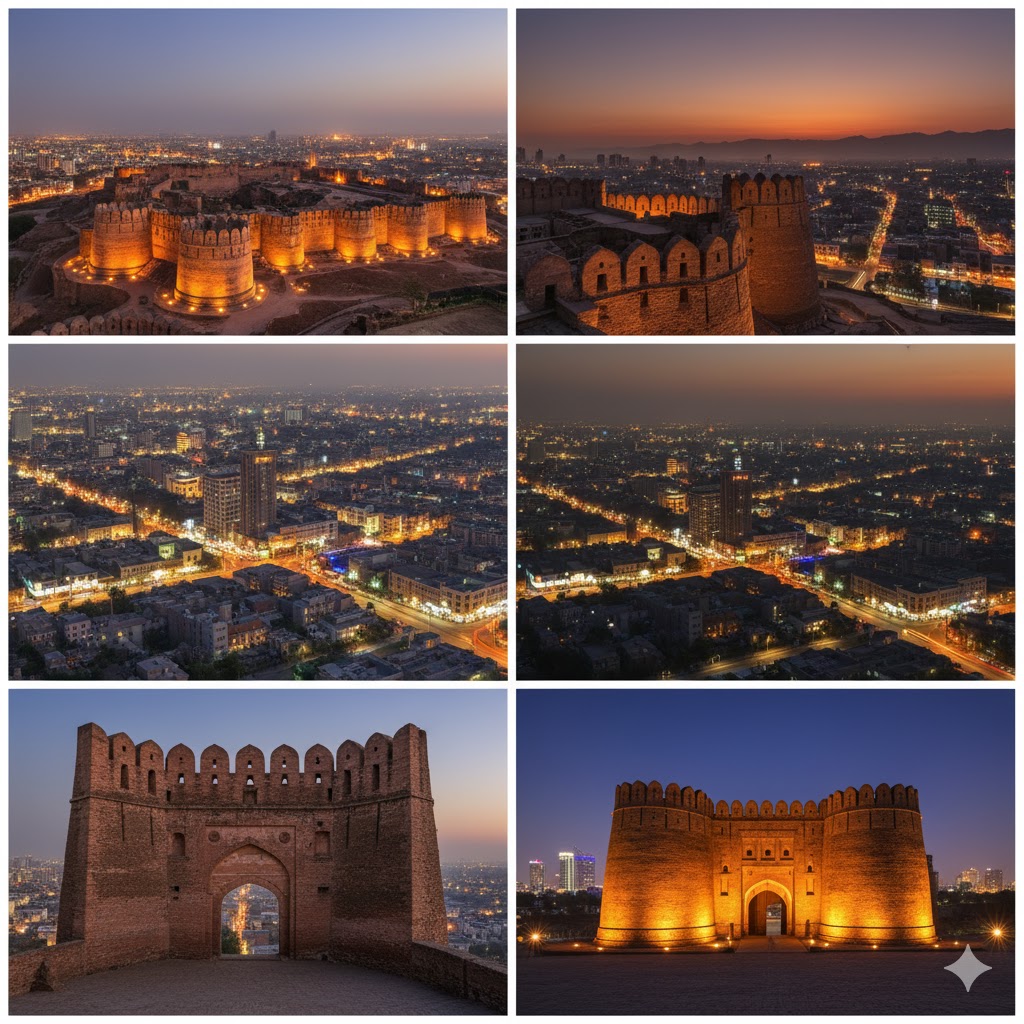
🌄 4. Swat Valley — The Lost Paradise of Gandhara
Known as the “Switzerland of Pakistan”, Swat combines natural beauty with deep cultural roots. Once a Buddhist hub, it’s home to stupas, monasteries, and relics that date back over 2000 years.
Tradition & Highlights: Sites like Butkara Stupa, Udegram ruins, and Jahanabad Buddha remain silent witnesses of the Gandhara Kingdom.
Hidden Gem: The Malam Jabba Monastery Ruins, hidden within ski slopes, are rarely visited even by locals.
Local Tip: Stay in Mingora for easy access; the local museum houses Buddha statues and coins unearthed from Swat excavations.
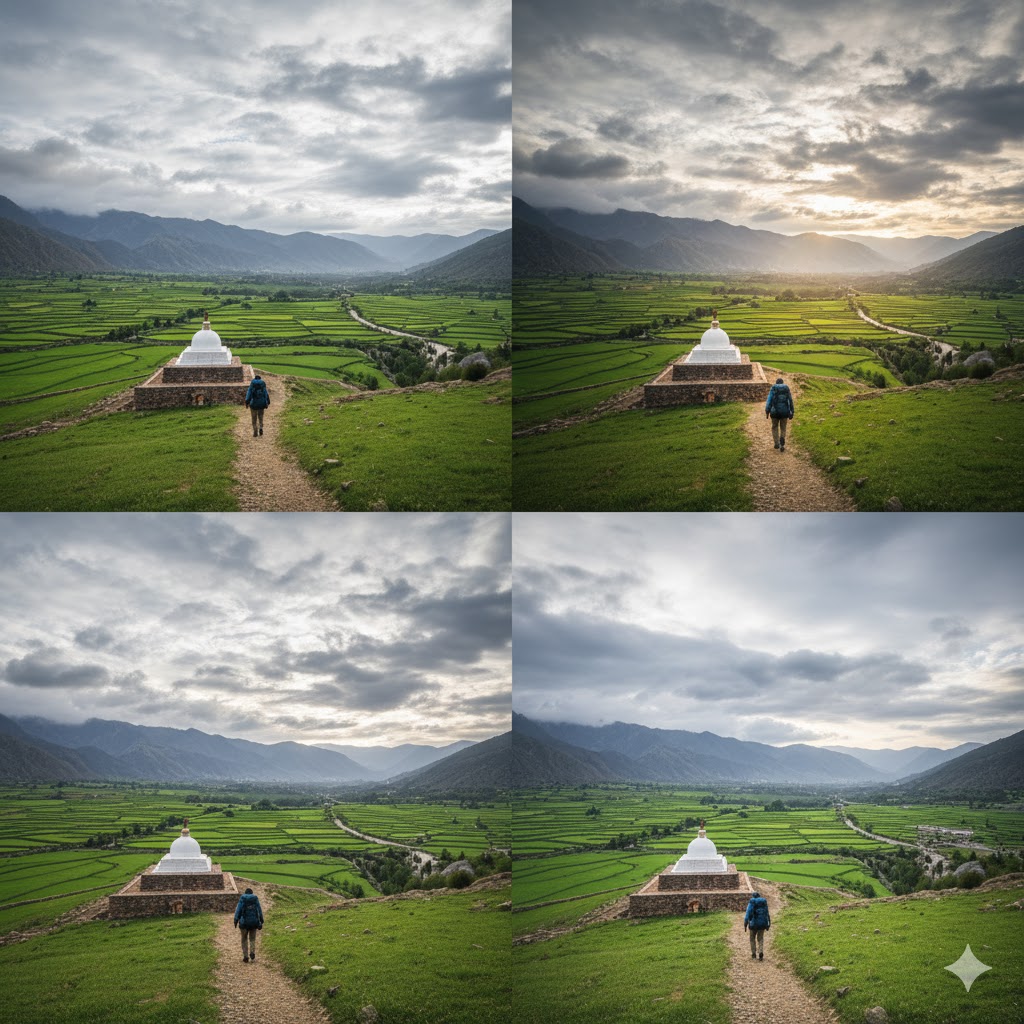
Source: Swat Museum & Heritage
🕌 5. Wazir Bagh & Gor Khatri — The Soul of Old Peshawar
Both Wazir Bagh and Gor Khatri offer glimpses of ancient urban life. Gor Khatri, meaning “Warrior’s Grave,” was once a Buddhist monastery, later turned into a caravanserai during Mughal rule.
Tradition & Highlights: Excavations reveal layers of civilizations — from Greek to Mughal — all coexisting within a few feet of soil.
Hidden Gem: An ancient Hindu temple structure lies beneath parts of Gor Khatri, accessible with special permission from the archaeology department.
🏔️ Gilgit Baltistan — The Roof of the World
If KPK is the land of warriors, then Gilgit Baltistan (GB) is the land of wanderers, mystics, and mountain dwellers. Situated where the Himalayas, Karakoram, and Hindu Kush meet, it holds an incredible mix of cultures, languages, and ancient Silk Route relics.
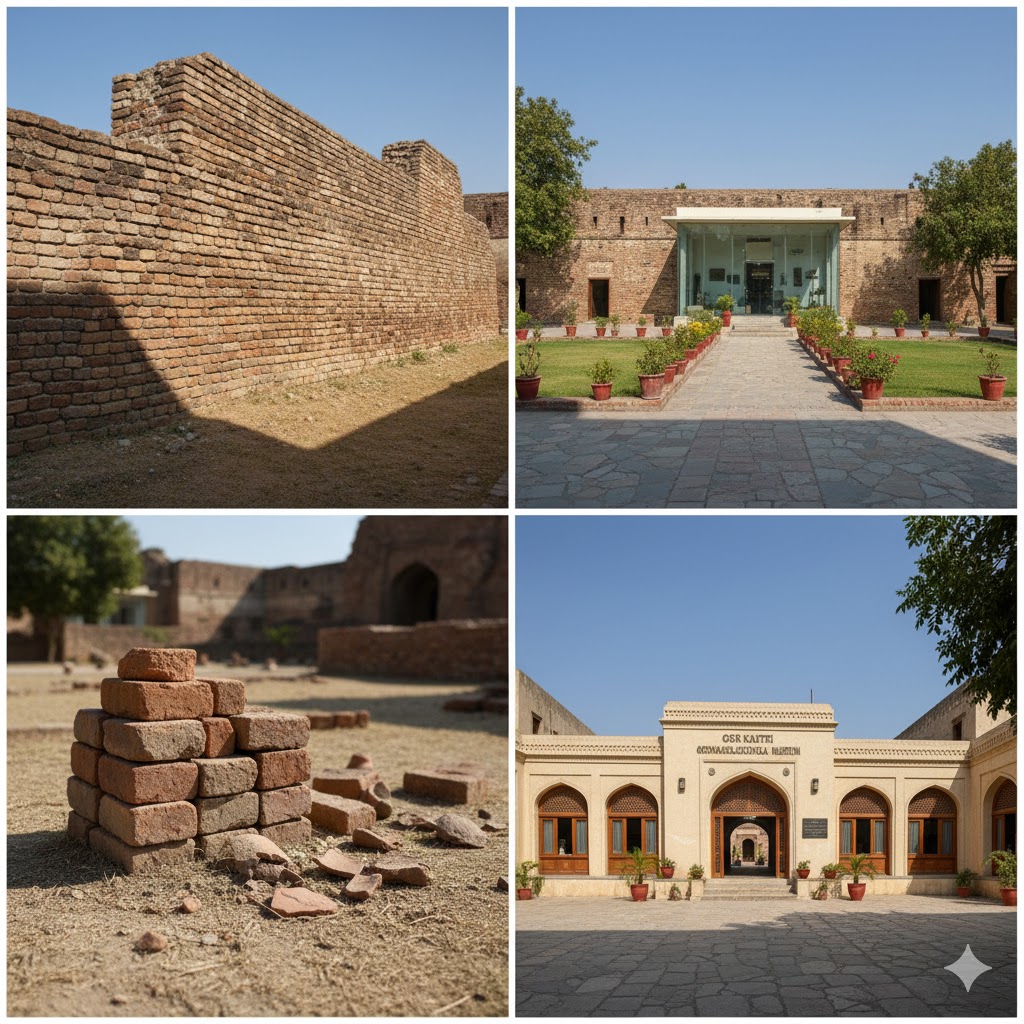
🏯 1. Baltit Fort — Hunza’s Ancient Guardian
Overlooking Karimabad, Baltit Fort dates back 700 years and stands as a living testament to Hunza’s royal history. Built by Tibetan craftsmen, its architecture fuses Himalayan and Tibetan influences.
Tradition & Highlights: Once home to Hunza’s Mirs, the fort now serves as a heritage museum under the Aga Khan Cultural Service Pakistan.
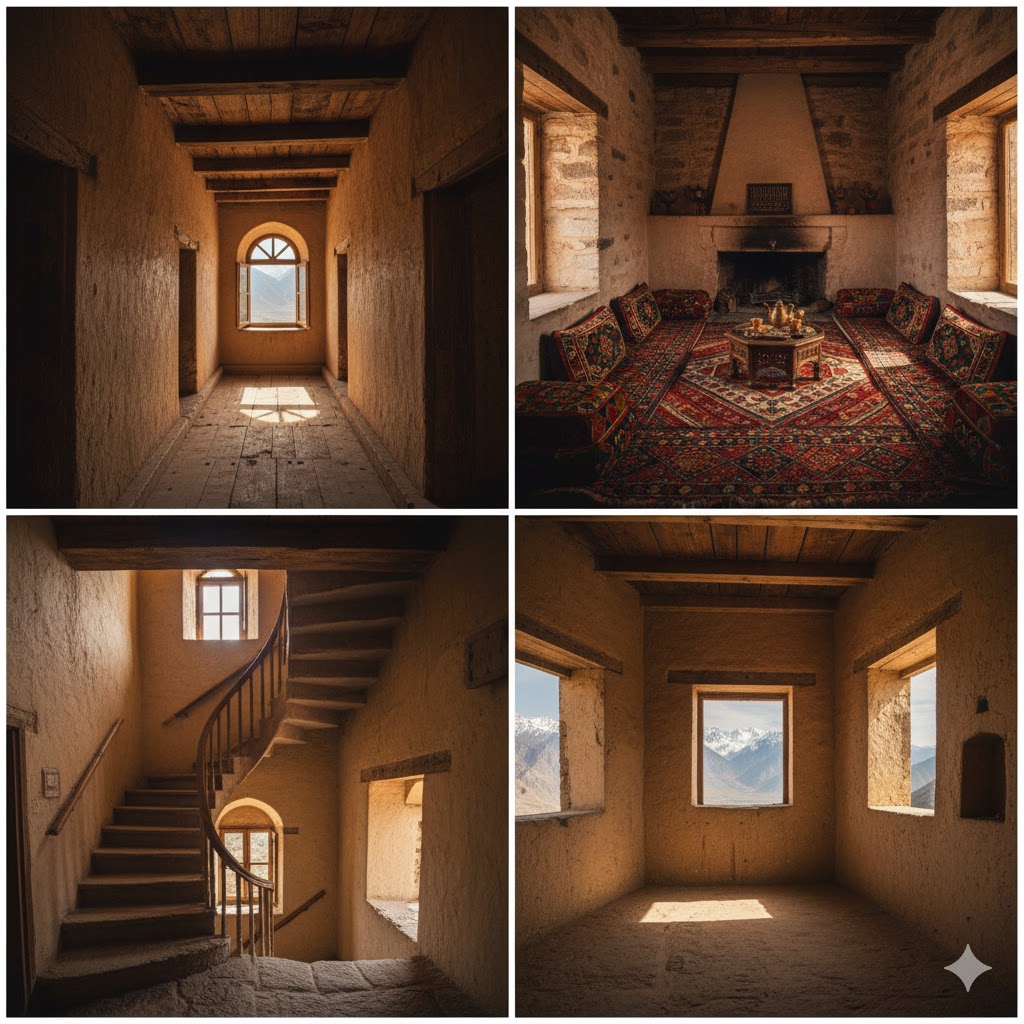
Hidden Gem: The narrow staircase leading to the upper gallery offers a bird’s-eye view of Hunza Valley at golden hour.
Local Tip: Visit at sunset; combine with nearby Altit Fort to understand Hunza’s royal evolution.
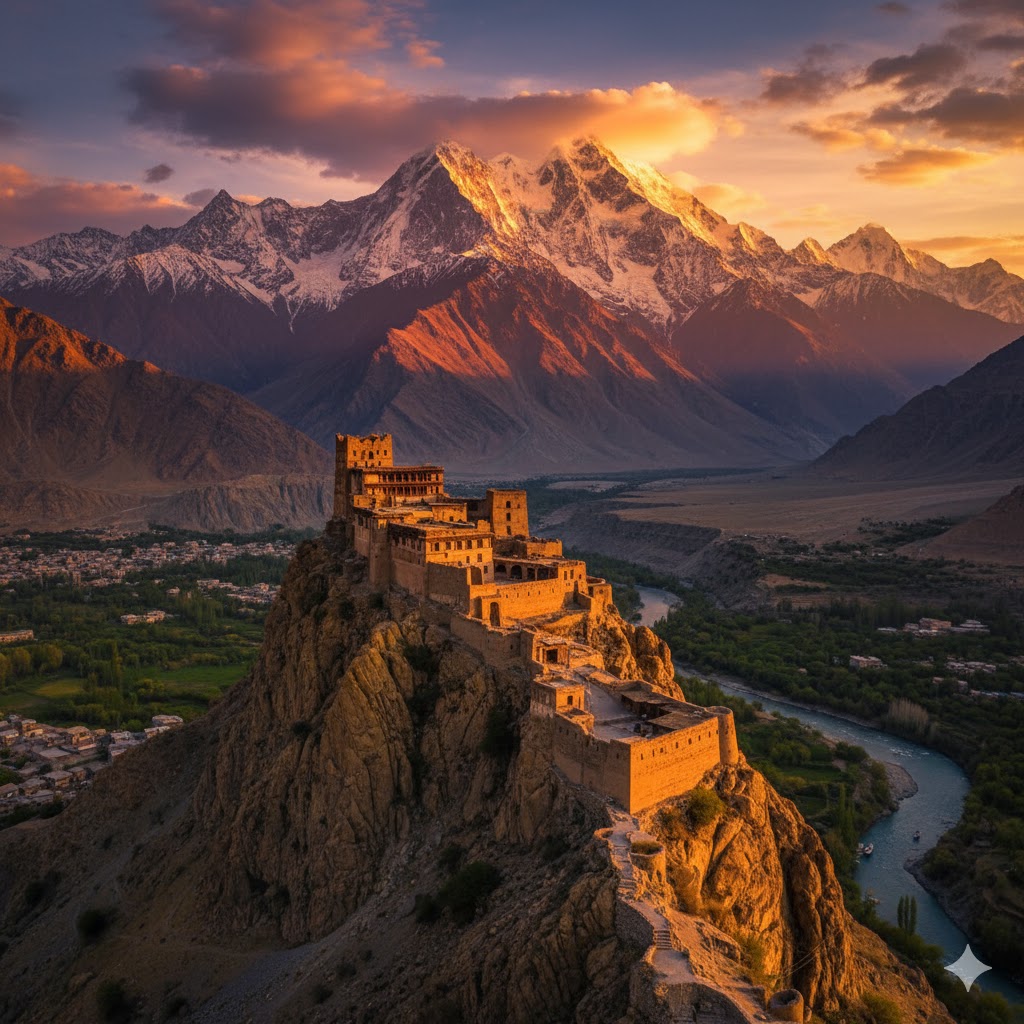
Source: Aga Khan Cultural Service Pakistan
🏰 2. Altit Fort — Where Time Begins
Older than Baltit, Altit Fort (900 years old) was the seat of Hunza’s earliest rulers. The fort’s wooden balconies overlook Hunza River, and its stone architecture showcases the oldest surviving construction in Gilgit Baltistan.
Tradition: The Altit Women’s Café, run by local women trained in hospitality, offers visitors authentic apricot juice and walnut cakes — proceeds go to community welfare.
Hidden Gem: The Royal Garden behind the fort grows ancient apricot and apple trees from the original Hunza plantations.
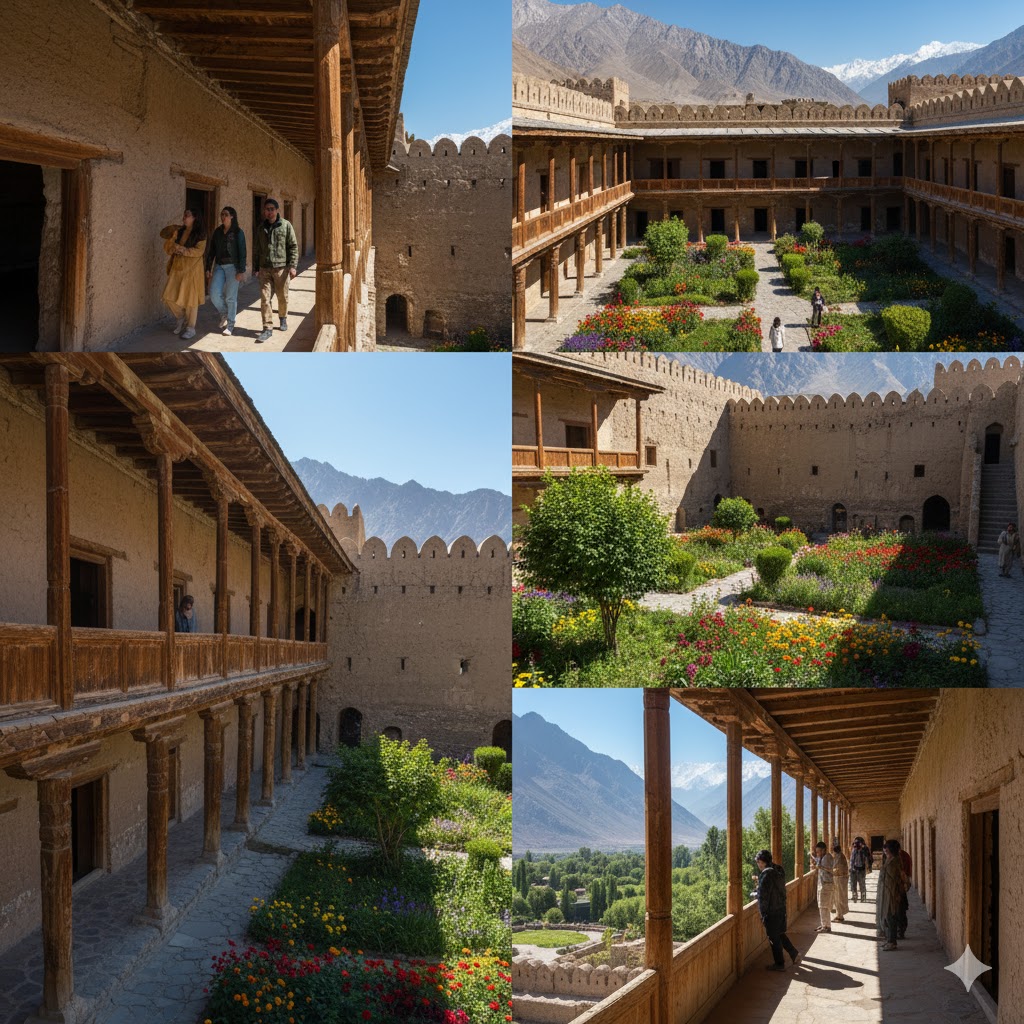
🪶 3. Shigar Fort — The Palace on the Rock
Located in Shigar Valley, this 400-year-old fort-palace was restored by the Aga Khan Trust for Culture and now operates as a heritage hotel. Its name literally means “Fort on the Rock.”
Tradition & Highlights: Guests can stay in the restored royal suites, dine on Balti cuisine, and explore the blend of Tibetan, Kashmiri, and Persian architectural elements.
Hidden Gem: The organic orchard within the fort grounds grows fruits for in-house dishes — apricot soup is a must-try.
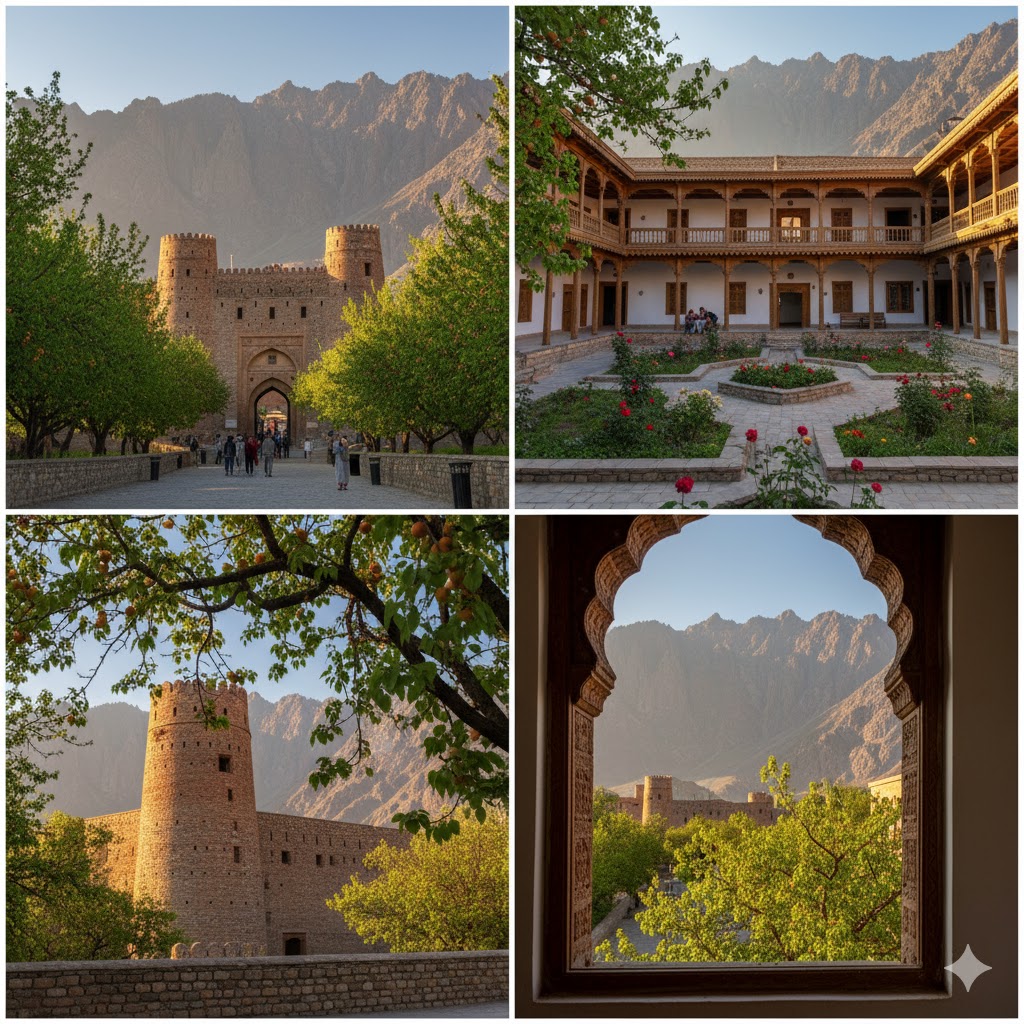
Source: Serena Shigar Fort Official Site
🕌 4. Khaplu Palace — The Last Frontier Palace
The Khaplu Palace, built in the 19th century, represents the final architectural expression of Balti royal tradition. Now a museum and boutique hotel, it’s often called the “Last Frontier Palace of Pakistan.”
Tradition & Highlights: The palace preserves royal weapons, textiles, and rare photographs of the former Yabgo Dynasty.
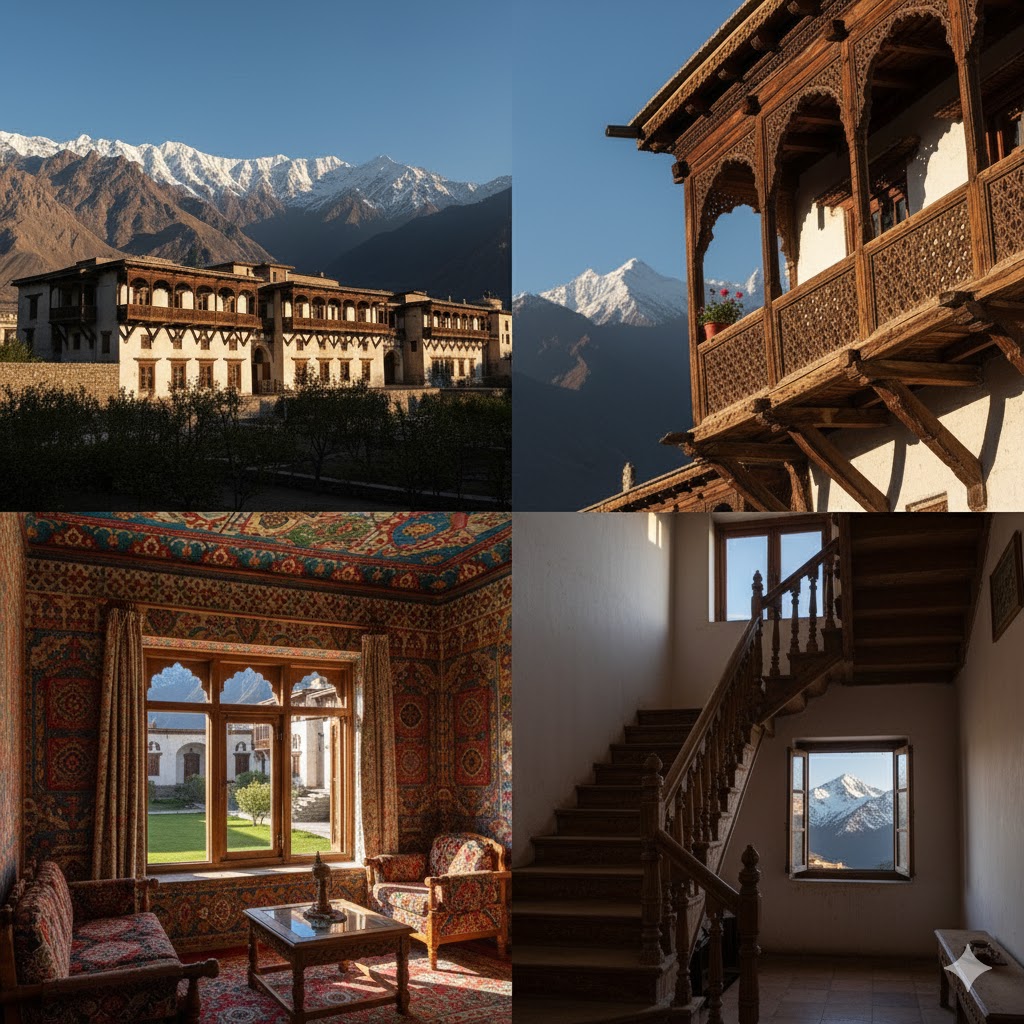
Hidden Gem: The rooftop prayer hall offers a serene space with panoramic views of the Khaplu Valley.
Local Tip: Try the Balti Shapik bread and yak butter tea served in the palace café.
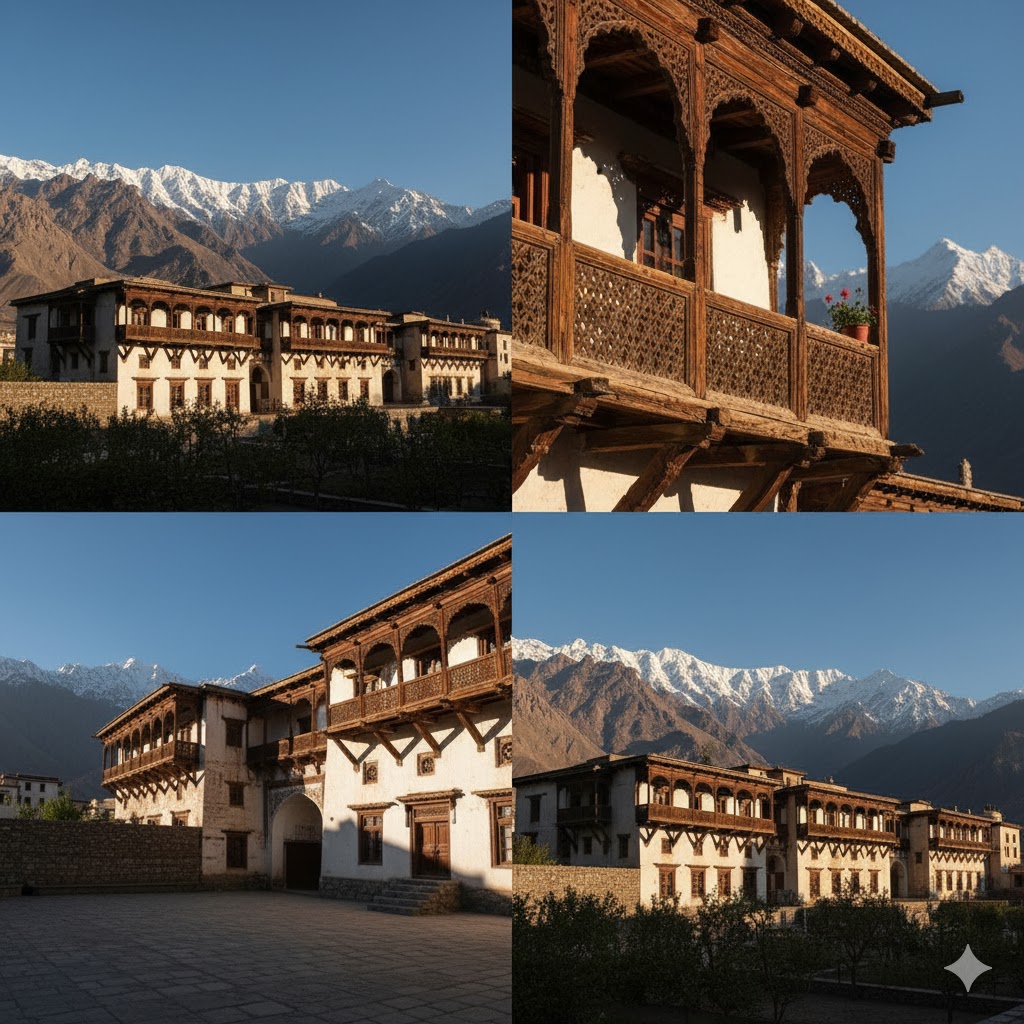
🏞️ 5. Manthal Buddha Rock — Echoes of the Silk Road
Just outside Skardu, this ancient Buddhist carving from the 8th century depicts a large meditating Buddha surrounded by smaller Bodhisattvas — a sign of the region’s Buddhist past before Islam’s arrival.
Tradition & Highlights: Pilgrims and historians visit to understand the spread of Buddhism across the Karakoram.
Hidden Gem: Early morning sun enhances the gold hues of the rock carving — ideal for photography.
Entry Fee: Free.
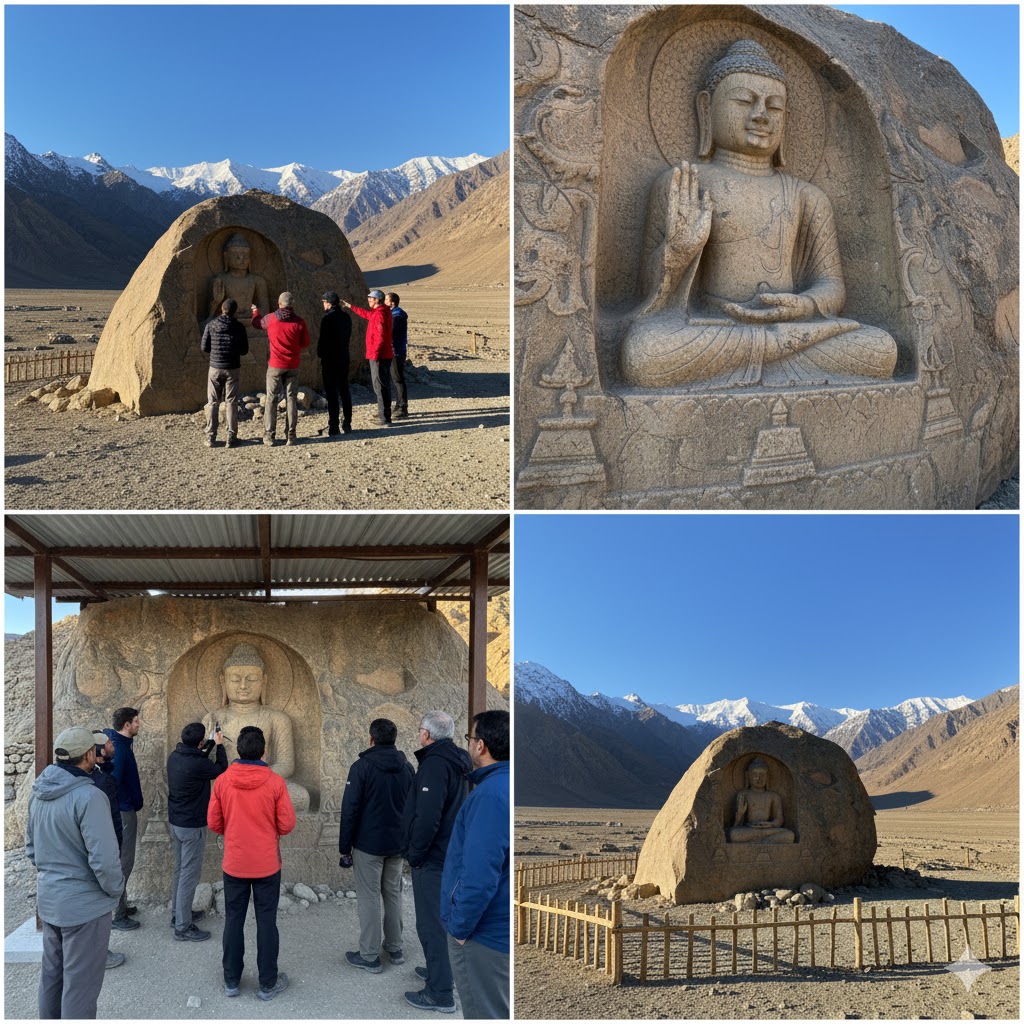
🏔️ 6. Kargah Buddha — The Guardian of Gilgit
Carved high into a cliff outside Gilgit, the Kargah Buddha is another remnant of the Gandhara-Baltistan cultural fusion. Locals call it Yachani, meaning “the Great Saint.”
Local Tip: Hire a jeep or bike from Gilgit city center; the climb is steep but rewarding.
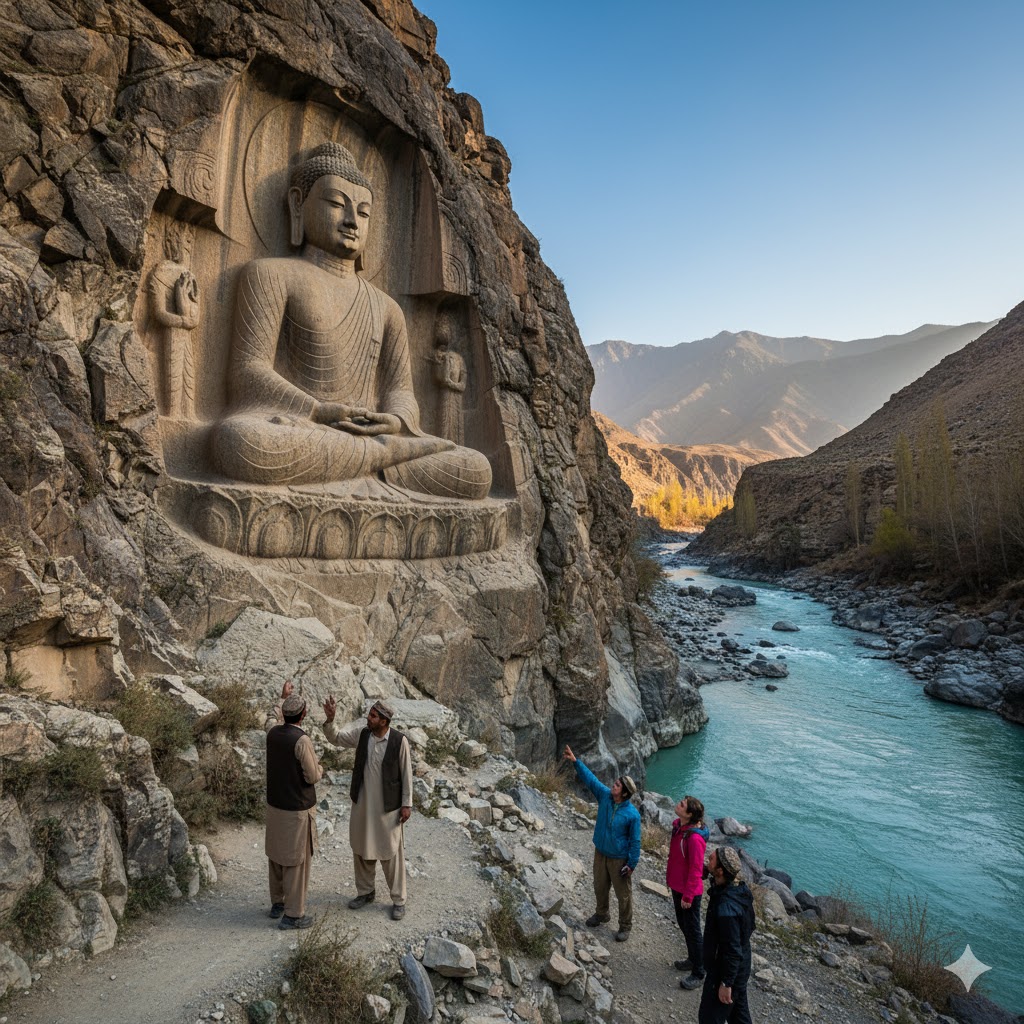
🌸 7. Hidden Villages and Remote Heritage Trails
Beyond the forts and relics, Gilgit Baltistan is full of hidden heritage treasures — small villages that keep ancient traditions alive:
- Ganish Village (Hunza): UNESCO-recognized settlement, 1000 years old.
- Passu Village: Known for its centuries-old stone houses and view of Passu Cones.
- Kharmang Valley: Hosts the Manthokha Waterfall, and ancient shrines of early traders.
- Basho Valley: Famous for its wooden mosques and centuries-old walnut trees.
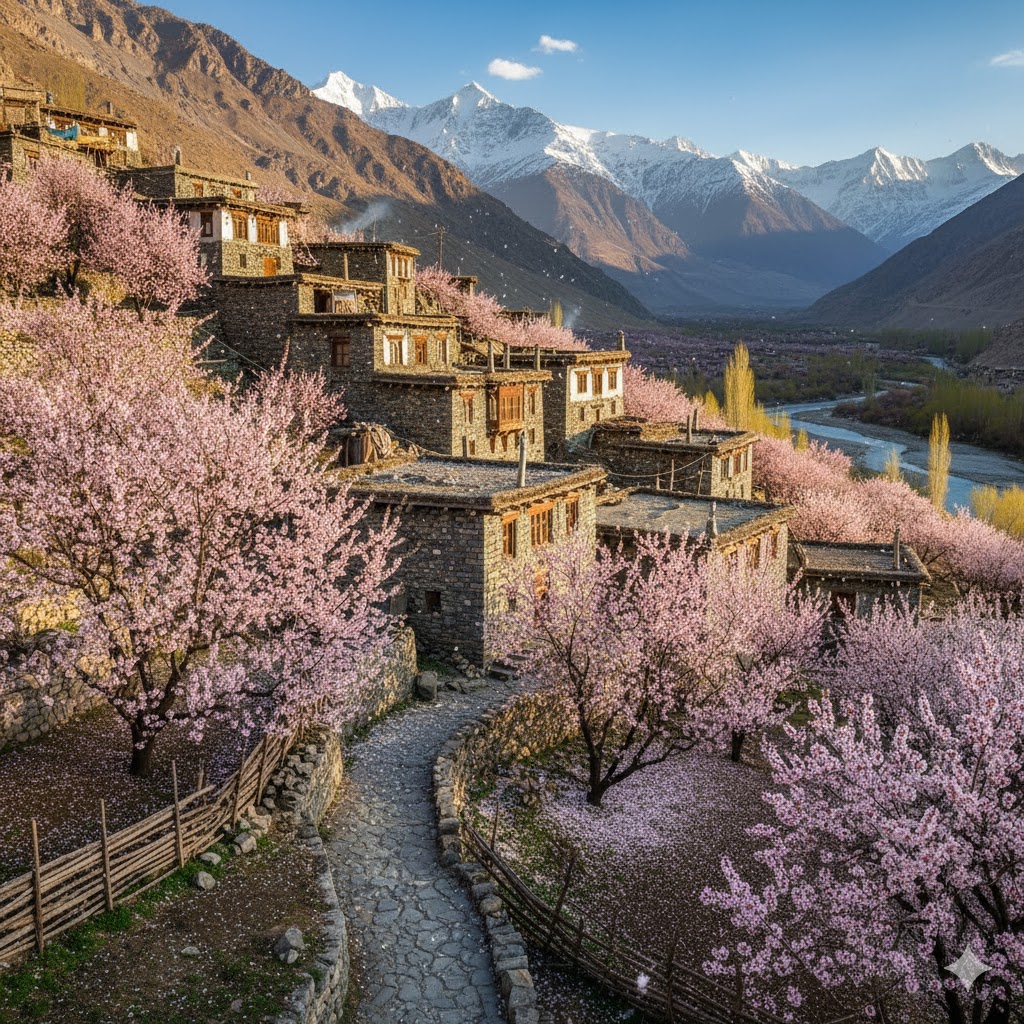
Modern Preservation Efforts & UNESCO World Heritage in Pakistan
Pakistan’s cultural and architectural history faces both opportunities and challenges. Over the decades, the government, UNESCO, and private heritage foundations have united to protect and restore the timeless treasures of the land.
🌍 UNESCO World Heritage Sites in Pakistan
Pakistan is home to 6 recognized UNESCO World Heritage Sites, each narrating a different era and civilization:
- Archaeological Ruins of Moenjodaro (Sindh) — A gem of the Indus Valley Civilization dating back to 2500 BCE, this ancient city reveals the world’s first urban planning, sewage, and architectural systems.
- Hidden Gem: Visit early morning to see the sun cast shadows on millennia-old bricks.
- Local Tip: The on-site museum displays terracotta figurines and seals — a must-see for history students.
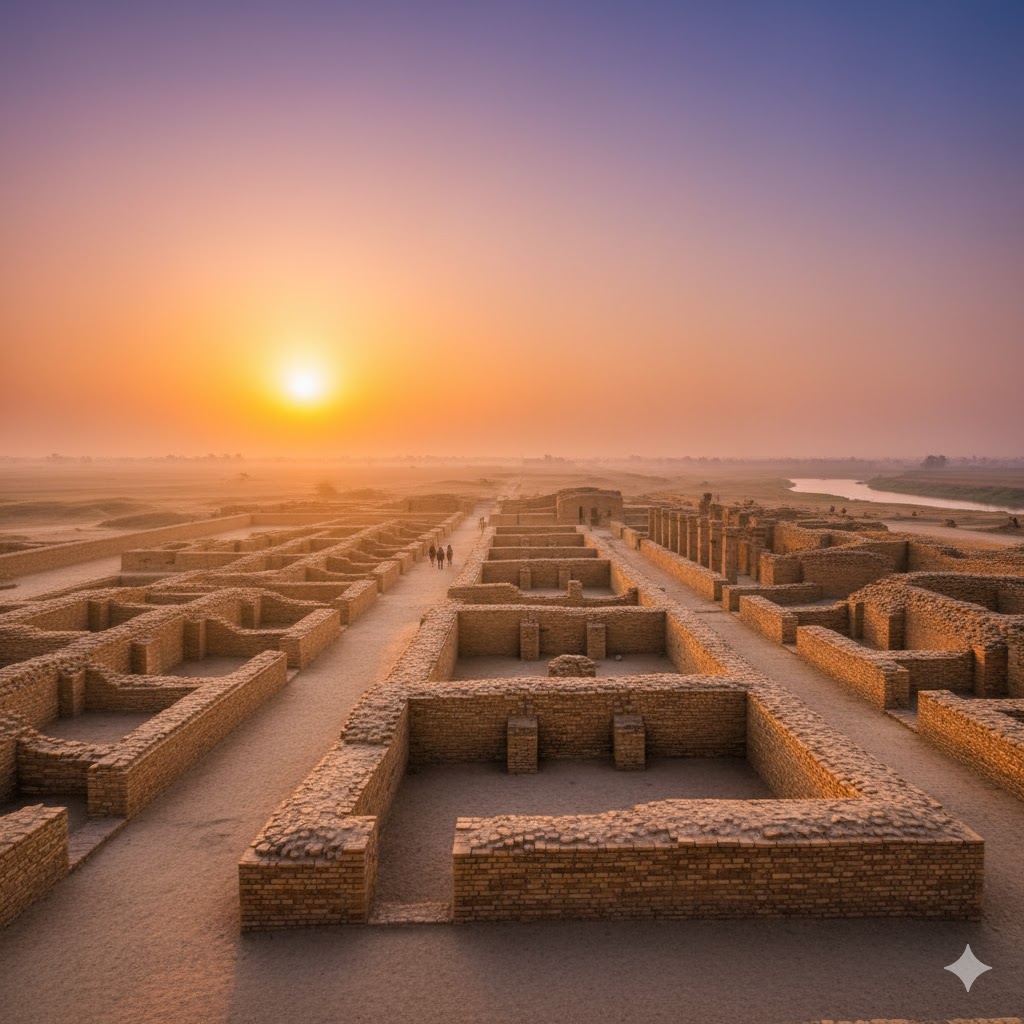
- Taxila Ruins (Punjab) — A seat of Buddhist learning where Alexander’s influence met Gandharan art.
- Highlight: Dharmarajika Stupa and Jaulian Monastery show intricate Buddhist carvings.
- Local Tip: Bring a guide; ruins are scattered across several kilometers.
- External Link: UNESCO Taxila Site
- Rohtas Fort (Punjab) — Built by Sher Shah Suri in the 16th century to defend his empire, this colossal fort is still impeccably preserved.
- Hidden Gem: Sohail Gate offers the best sunset photography in Punjab.
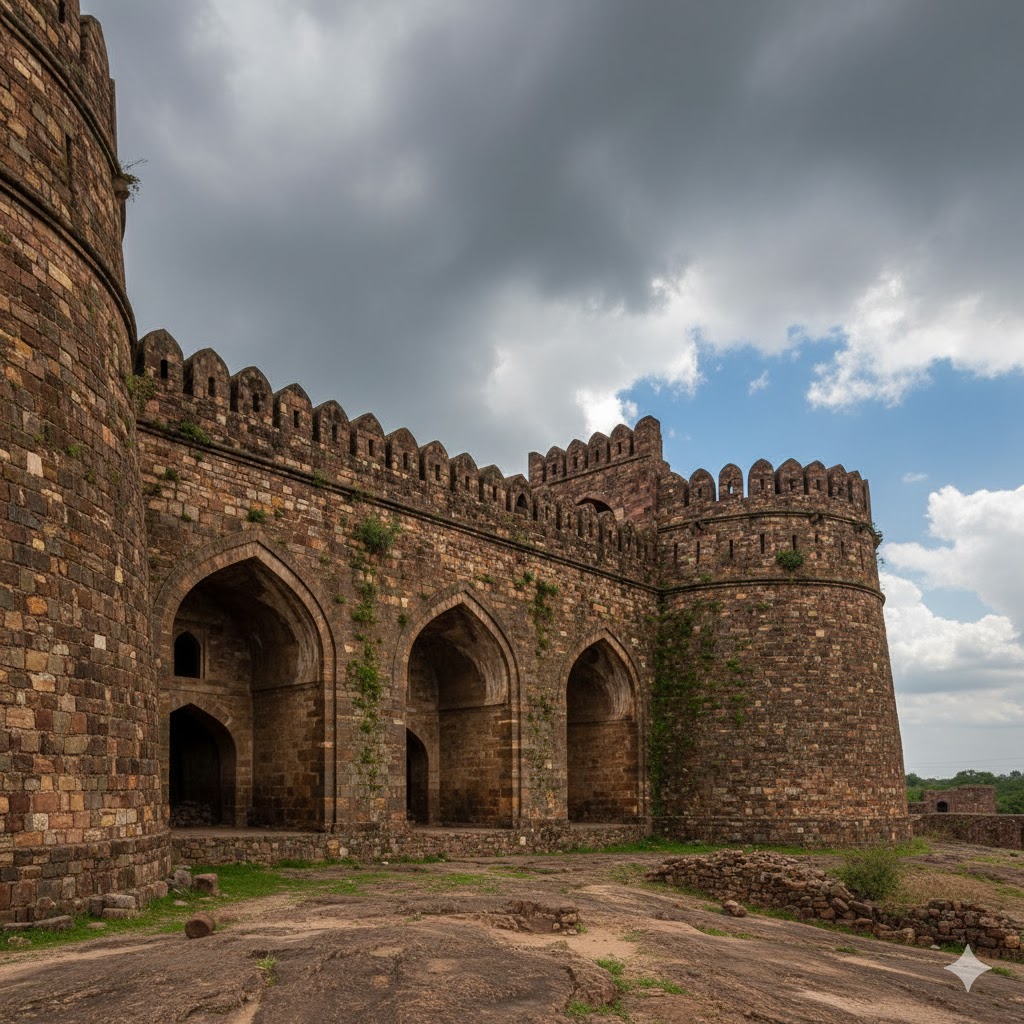
- Makli Necropolis (Sindh) — One of the world’s largest funerary sites, with over 500,000 tombs showcasing a fusion of Islamic, Hindu, and Persian art.
- Local Tip: Visit during golden hour for mesmerizing carvings.
- Lahore Fort & Shalimar Gardens (Punjab) — Mughal architecture in its purest form, featuring mirrored palaces and royal gardens.
- Hidden Gem: The Sheesh Mahal sparkles like starlight when lit by a single candle.
- External Link: Lahore Fort Heritage Information
- Buddhist Ruins of Takht-i-Bahi (KPK) — A 1st-century monastery perched on a hill near Mardan, still echoing the chants of monks who once meditated there.
- Local Tip: Best visited at dawn — the valley fog adds a mystical atmosphere.
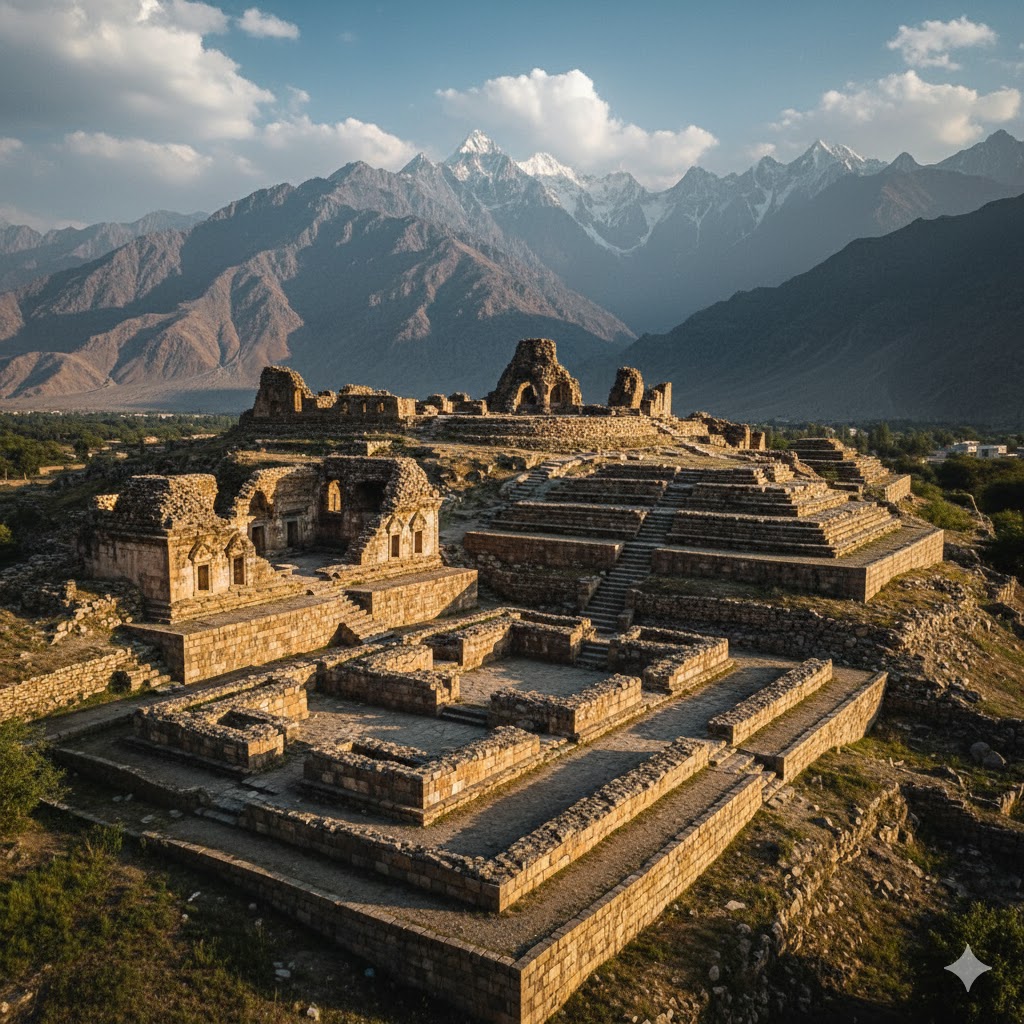
🏗️ Heritage Preservation Efforts in the 2020s
Pakistan’s government, cultural ministries, and local NGOs have made strong progress in heritage preservation:
- National Heritage and Culture Division launched Project Revive 2030, focusing on digital mapping of historical monuments.
- Akhuwat Heritage Foundation and Lahore Walled City Authority (WCLA) work on restoring old bazaars, havelis, and street art.
- Private initiatives such as Heritage Now Festival Lahore celebrate Pakistani architecture through film, art, and workshops.
- Youth and Students’ Heritage Walks are bringing university groups closer to their history — particularly in Multan, Swat, and Hunza.
💡 Hidden Gem: The newly restored “Shahi Hammam” in Lahore’s Delhi Gate area showcases 400-year-old frescoes that had been buried under plaster for centuries.
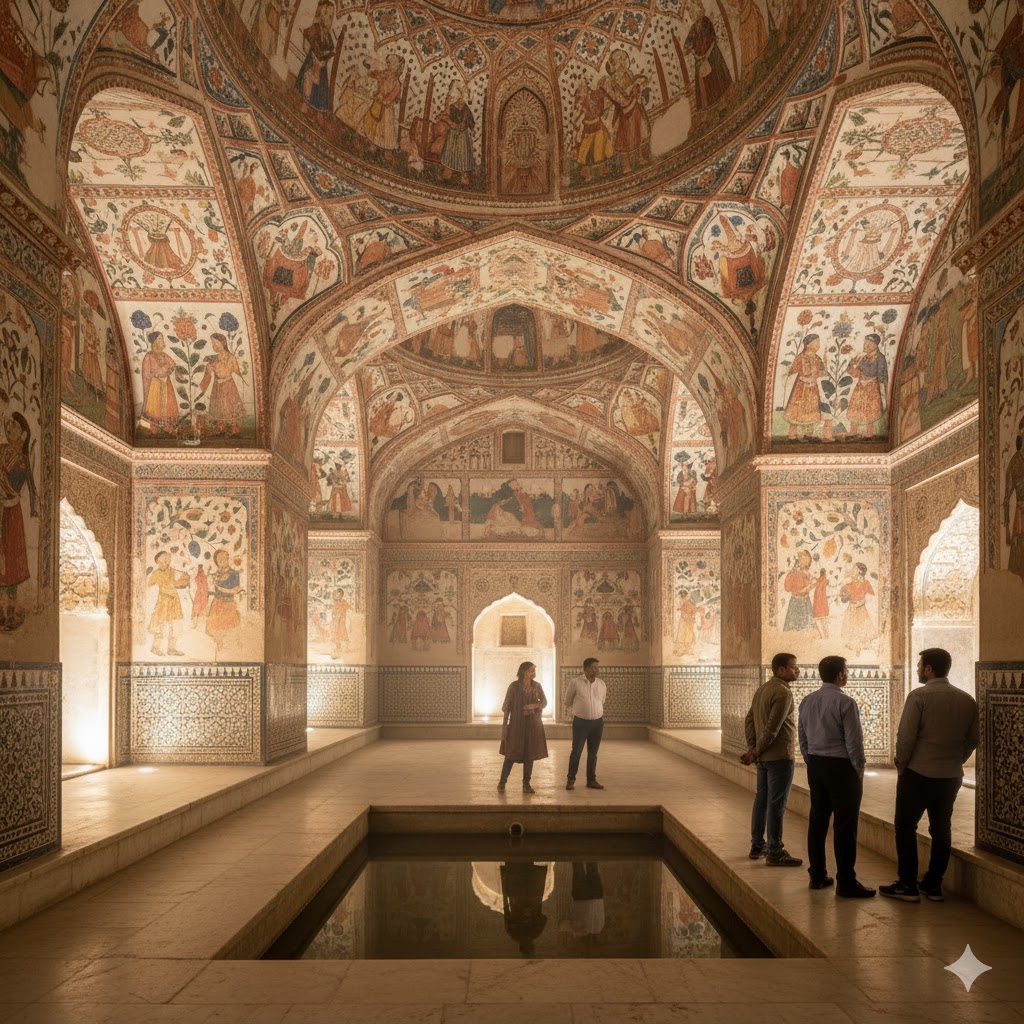
🕊️ Northern Heritage Meets Modern Tourism
In the north, preservation meets adventure.
Tourists exploring Hunza, Skardu, and Gilgit are now experiencing both heritage stays and eco-cultural projects:
- Khaplu Palace & Serena Heritage Hotel: A restored 19th-century royal residence that now functions as a luxury eco-lodge.
- Altit Fort & Baltit Fort (Hunza): Managed by the Aga Khan Cultural Service, these restored forts serve as community museums, promoting women-led tourism.
- Local Heritage Tours: Villagers now offer storytelling walks about Hunza’s oral traditions and legends of the Silk Route.
🎭 Festivals Celebrating Heritage
To keep ancient traditions alive, Pakistan hosts heritage-focused festivals each year:
- Lok Virsa Festival (Islamabad) — A national heritage fair uniting crafts, music, and cuisines from all provinces.
- Sindh Literature Festival (Karachi) — Celebrates Sindh’s language, Sufi poets, and Ajrak culture.
- Heritage Mela Multan — Sufi qawwalis and pottery workshops inside the old fort.
- Hunza Cultural Festival — Promotes music, dance, and food traditions of Gilgit Baltistan.
💬 Local Tip: Many of these events have free entry for students and content creators with university IDs.
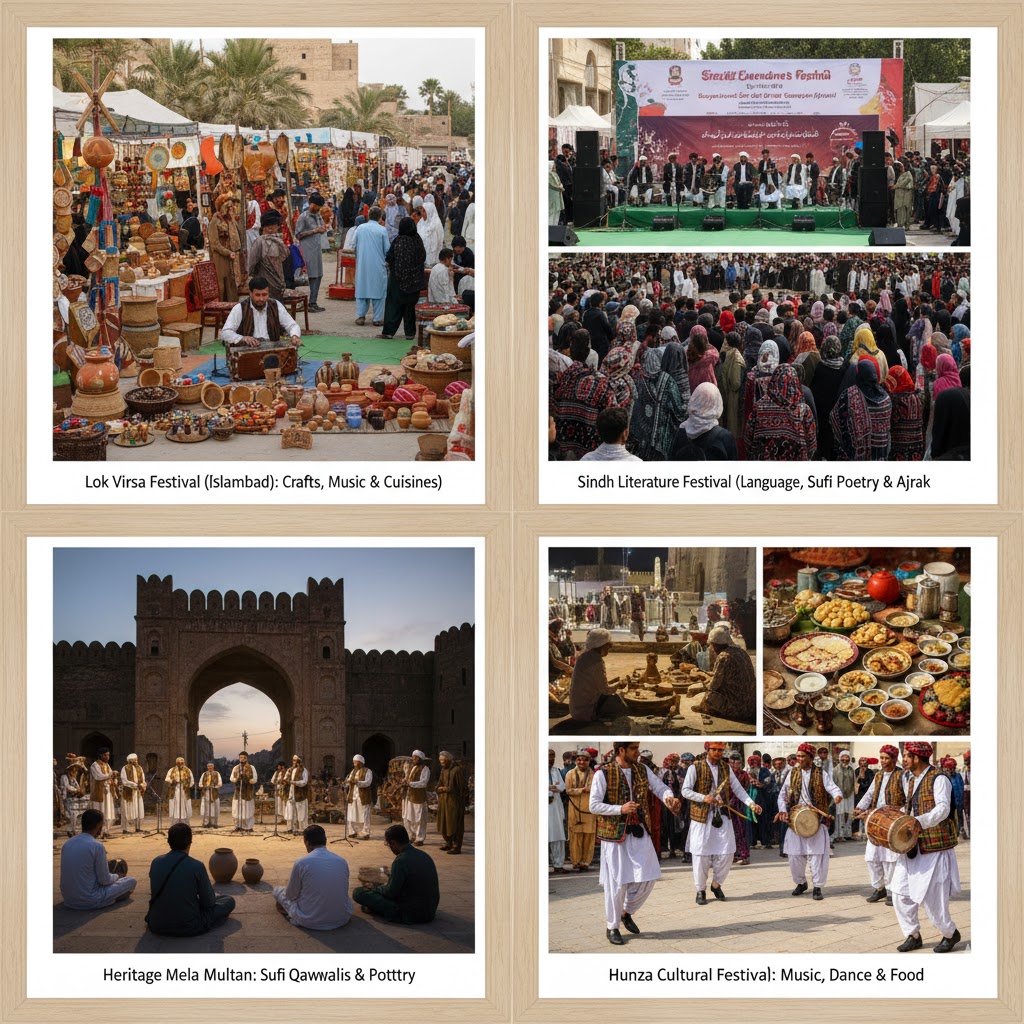
📚 FAQs — Heritage in Pakistan (2026)
Q1: What are the top heritage sites to visit in Punjab?
A1: Lahore Fort, Shalimar Gardens, Rohtas Fort, Taxila Museum, and Derawar Fort are must-see for heritage enthusiasts.
Q2: Which heritage spots in Sindh are worth visiting?
A2: Moenjodaro, Makli Necropolis, Shah Jahan Mosque in Thatta, and Ranikot Fort.
Q3: What are the best-preserved heritage sites in KPK?
A3: Takht-i-Bahi, Swat Museum, and Gor Khatri in Peshawar.
Q4: Are there any Buddhist sites in Pakistan?
A4: Yes, Taxila, Takht-i-Bahi, and Dharmarajika Stupa are major Buddhist heritage landmarks.
Q5: How can tourists access Gilgit Baltistan heritage areas?
A5: Flights from Islamabad to Skardu or Gilgit, followed by jeep or van rides to forts and ancient settlements like Altit and Khaplu.
Q6: Is photography allowed at heritage sites?
A6: Generally yes, but flash photography is restricted in museums and some shrines.
Q7: Are there local guides available?
A7: Yes, heritage-trained guides are available in major cities like Lahore, Karachi, and Skardu.
Q8: Which time of year is best for heritage tours?
A8: October to March offers pleasant weather, especially for exploring outdoor forts and ruins.
Traveler Guide: Heritage in Pakistan
Pakistan’s heritage is not just carved in stones and ruins — it lives in the rhythm of drums, the aroma of ancient streets, and the smiles of mountain villagers who still carry their ancestors’ stories.
From the grandeur of Mughal architecture in Punjab to the Buddhist wisdom of KPK and the ancient Indus spirit of Sindh, the country’s heritage continues to breathe, evolve, and inspire.
🌿 Travel Tip: Whether you’re a student explorer, cultural vlogger, or history buff — Pakistan’s heritage is best experienced with open eyes and a curious heart.
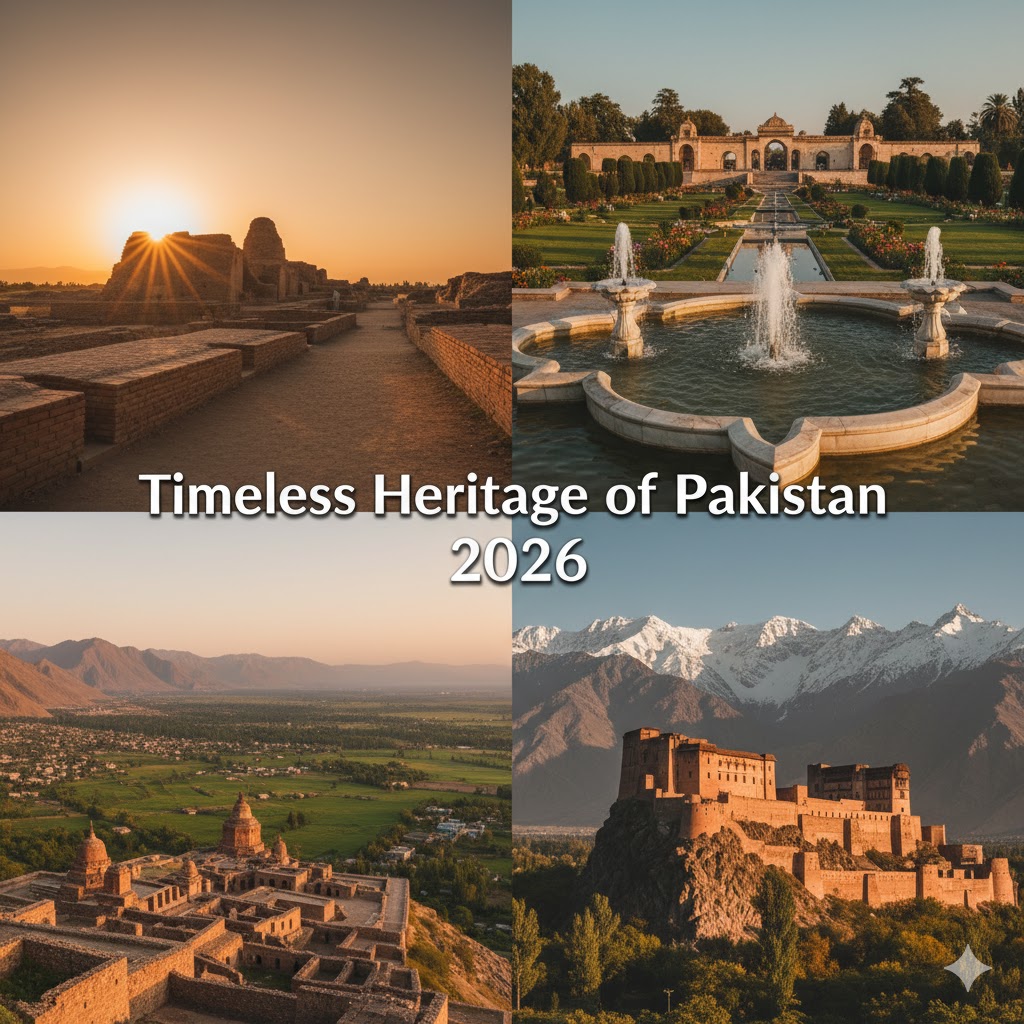

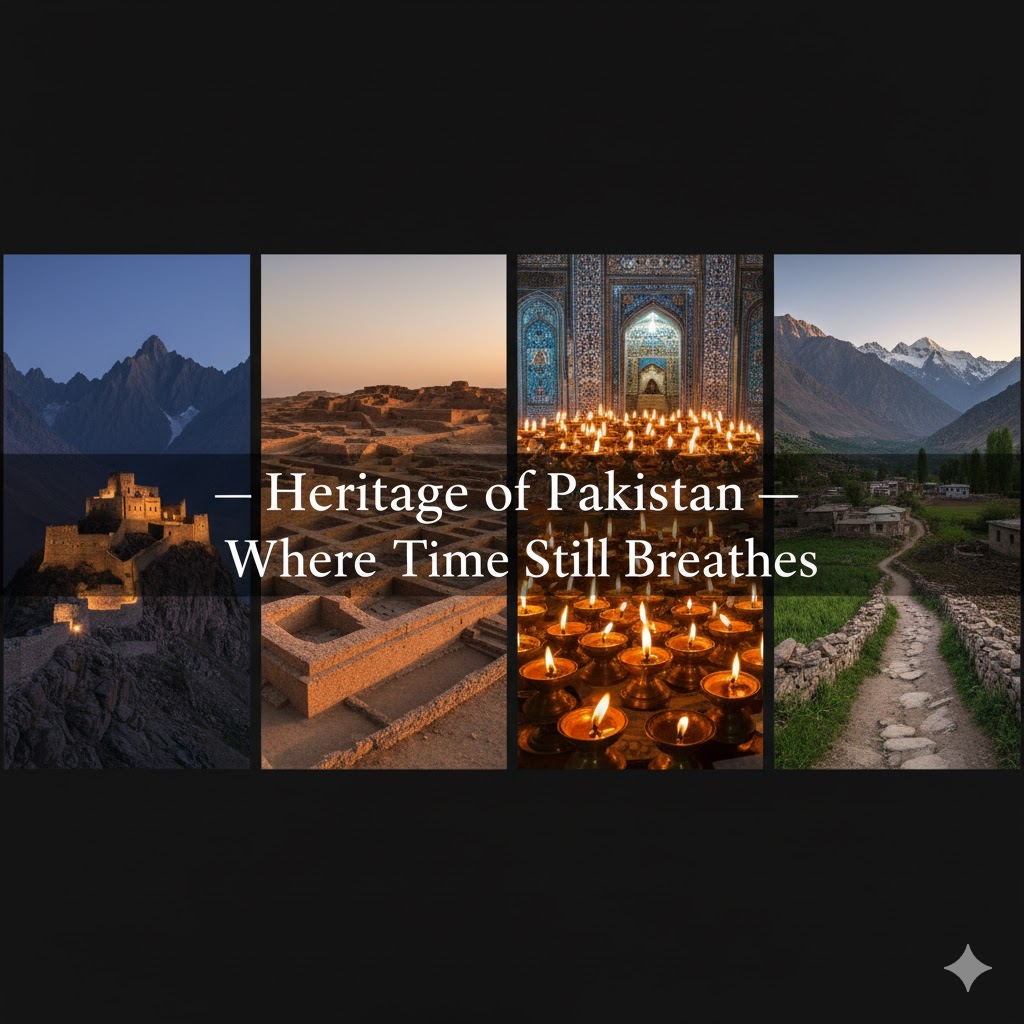
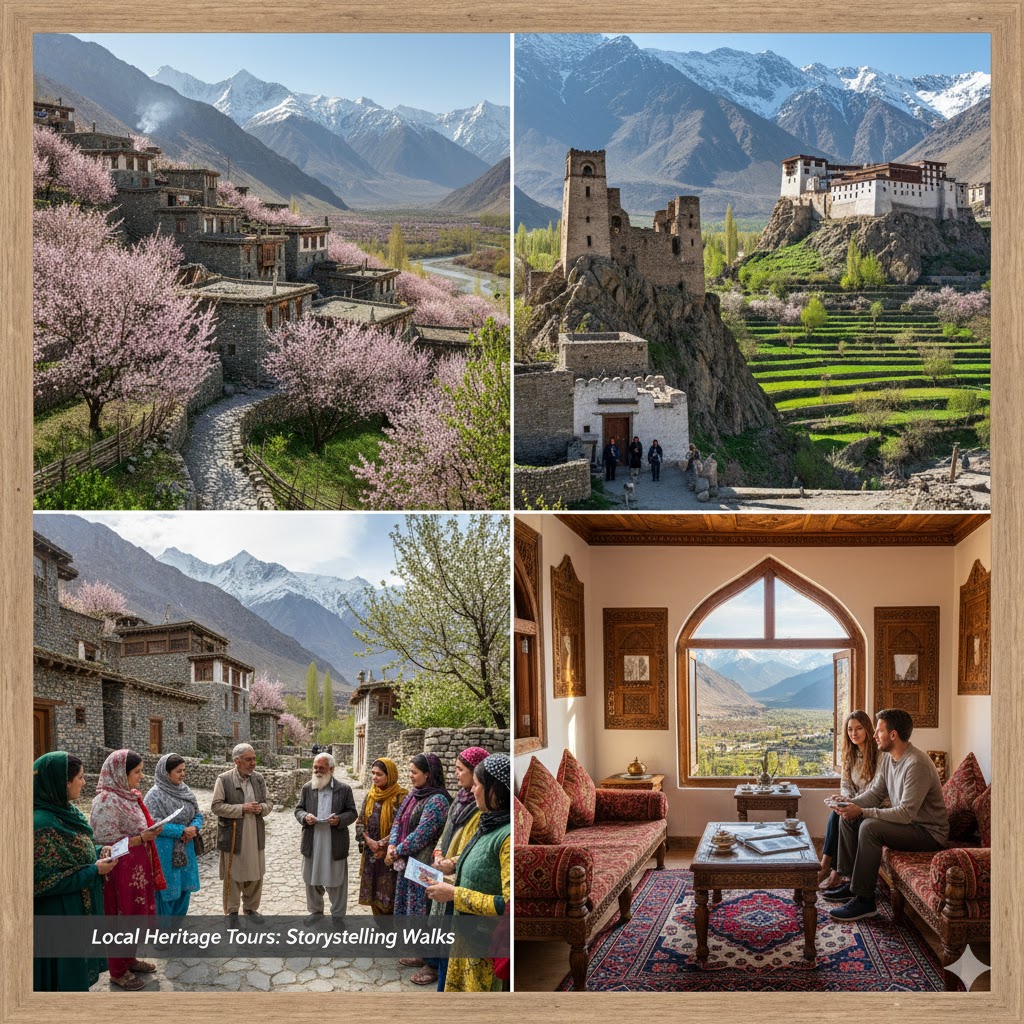


Pingback: Majestic Historic Forts in Pakistan 2026 Epic Guardians of Time